Campus Update for the Week November 29-December 2 (going out a little early due to my attendance at this week’s LFC meetings)
This will be the last weekly update for this term…many thanks to everyone who read the updates and thanks again, to those who provided me with some feedback and sometimes inspiration in response to my messages.
COVID
The incentive checks to students are scheduled to go out early next week. HU students recently received an email reminding them of our campus COVID requirements and moving closer to more serious repercussions if they fail to comply. Turning to the staff and faculty, it is not clear when the legal issues associated with the proposed OSHA requirements will be determined by the courts. If you recall, those requirements require businesses (including universities) to require a vax registration for all who work there or submit to weekly testing (weekly testing exceeds our current standard). If these recommendations ultimately make their way out of the courts, businesses and organizations may be fined up to $14,000 per instance of noncompliance.
Recent COVID news has focused on a new variant and that could certainly cause us trouble. Again, I am no expert, but it does appear to me that (1) there is virtually zero interest in going back to any type of major lockdown and (2) we are inching closer and closer to some type of national vaccination requirement for all citizens without some type of exemption. I know that second issue will result in all kinds of legal issues, demonstrations, etc., but I think trends suggest that might be where we are going.
I continue to be very concerned about mental health issues associated with COVID, and we’ve had several recent incidents here on campus. I have received a recommendation from the faculty about an initiative to improve mental health, and I appreciate their recommendation very much. I need to be certain that we can use our COVID relief dollars to implement that initiative, and I am checking on that now. Please…I implore everyone to check in on their own mental health status on a regular basis and take action if they need some assistance.
Get vaccinated. Get the booster. I was on a state COVID meeting the other day, and the experts noted that the clear majority of people getting very ill or dying were unvaccinated. Use your best judgement to determine what kinds of things you are willing to do, attend and so on. Check in frequently on your own mental health and don’t hesitate to seek some assistance. Be kind and gentle with others even if they are not. You don’t know what they might be dealing with so give them a break. Do something fun. We are very fortunate here in New Mexico to have easy access to many outdoor pursuits and experts suggest that those are relatively safe. But, of course, no activity is 100% safe. Help someone during this time. As I write this, the sun is shining on a bluebird-sky Northern New Mexico morning and I am at my desk privileged to do a job that might help others achieve their dreams. There’s a long line of people who would do just about anything to do what I do…I would say, what we collectively do at Highlands. So, some aspects of life are simply wonderful…even under COVID conditions.
Run-Up To The Legislative Session
This Saturday, the Council of University Presidents will be presenting its proposal for this year’s legislative session. I think it is a good package and am hopeful we’ll achieve at least some of our goals. There’s a lot in the CUP’s recommendation, but two major recommendations pertain to I&G funding and compensation. We will be making a recommendation to increase I&G funding (that’s the money we use to support our core missions of instruction and research) somewhere closer to pre-recession levels. The I&G budget is key to all institutions of higher education including, of course, HU. We’ll be asking for a 7% increase in compensation, ideally with some latitude to address issues resulting from salary compression and inversion. Without the latitude to address those issues, compensation challenges such as compression and inversion just continue over time.
We’ve started with decent additional compensation requests before and sometimes end up with 0% or like last year, a modest 1.5%. But, there is more money available this year so perhaps we’ll land in a better place.
Again, my goals regarding compensation:
Overarching Goal: NMHU will be regarded as the best employer in Northern New Mexico. To achieve that goal:
Minimum compensation of $15 per hour and then adding to that over time. According to national studies, $15 is a “livable wage” in San Miguel County for a single person. It is not a livable wage if you have more than a single person in the household, so we need to address that. For more details, go to https://livingwage.mit.edu/counties/35047. The $15 per hour standard will probably become state law anyway, but I am happy to say we are ahead of the curve on that one.
Compensating staff members a fair wage within the bands set by our compensation consultants and allowing for movement within and between bands as justified and feasible.
Achieving the top faculty compensation among all regional comprehensives in the state on the way to the top ¼ of our existing peers (in and out of state). My estimate to achieve the first faculty compensation goal is about a 10% increase.
I think every year I’ve been here, there has been at least some confusion around press releases about educator compensation and I’ve already received one call about an article in the Albuquerque paper. Here it is: https://www.abqjournal.com/2450795/lujan-grisham-proposes-7-raise-for-nm-educators.html. There is a distinction here in New Mexico between state mandated raises for people referred to as “educators”(K-12 teachers) and raises for university faculty members. The article referenced above pertains to K-12–not higher education faculty. The CUP puts forth a proposal regarding faculty compensation and that recommendation is considered separately from raises for K-12 teachers. This year we are proposing 7% for higher education folks, but of course, there is no guarantee that’s where we’ll land. I will try my best, my colleagues.
I should also note that the salary differential between K-12 teachers and university faculty members is a very serious matter. Someone in my family recently moved to New Mexico and is earning $60K for teaching in one of the public schools. That’s for nine months. Obviously, no scholarly expectations. No real service expectations. No required terminal degree. K-12 teachers, in my opinion, deserve that salary and much more–teaching is one of the most important jobs in our society–but there are some higher education faculty in the state who do not earn that right now. That’s a problem.
I also remain committed to providing paid family leave to new parents and adoptive parents. You know, if other countries can do this, surely, we can as well.
Several HU Initiatives
We continue to pursue a few potentially very important initiatives at HU. The Center for Excellence appears to be a very good bet and I anticipate we’ll receive some new funds to get that started. There are several reasons I think we’ll get these new resources–the ongoing demand for social workers for one–but another is the very strong reputation of our programs in social work. So many people including many decision-makers regard that program very highly (and I certainly agree). Many kudos to the students, staff, faculty and administration of that program. However, the very heart of any truly excellent academic program are the faculty members in the program and we have an excellent group in that discipline, no doubt. Excellence does not happen by chance. We also continue to be very hopeful about the establishment of the Center for Reforestation. Quite a bit is on the line on this initiative–a new quarter-million dollar RPSP, a $1mil senate directed award, another $1mil matching grant including a six-figure commitment from private industry, a multi-million award to get the center started and ultimately, a $45-$55mil infusion of new money for a new building, greenhouses and other facilities. There’s no guarantee here, but as I wrote, I am optimistic. This initiative is a collaborative effort across two research institutions, state government, private industry, federal sources and HU. It would be the largest collaboration since I arrived at HU and if it comes to pass, will make HU a national leader in this area. So, let us hope. Several other new programmatic initiatives are ongoing including our successful, thus far, collaboration with Wiley.
On the business-practices front, I now have recommendations from the VPs and other direct reports to strengthen the business practices in their respective units. Some cost money and some do not. I asked my direct reports for short-term or immediate solutions and ideas about longer term improvements. As anticipated, people submitted ideas ranging from additional training to hiring additional people to outsourcing. I need to determine what things would actually cost and then move forward. I will be reporting what those various paths forward look like as soon as they are set, which will be soon. We have already taken some actions to provide some immediate support and I’ll report on those as well.
I should note that making personnel changes these days is much easier said than done. HU continues to advertise for some positions with no interest…no applicants and we are not alone in this. Joan and I went to lunch the other day and could not find any desirable option open….no workers. Maybe it is a COVID thing. Maybe it is the Great Resignation. Maybe it is something else, but there is a severe shortage of people looking for work these days and the higher education sector is no exception.
Even during COVID, HU continues to support this year’s cohort of Legislative Fellows. Thus far, this year’s group has heard from me, Lt. Governor Howie Morales, AG Hector Balderas, various state cabinet secretaries and others. That program has attracted a great deal of positive attention from numerous elected officials and with good reason. The exposure those students have to high-level decision makers just might be life-changing. I recall a very important book published some years ago–What Matters in College by Alexander Astin and he found that the experiences provided to our Legislative Fellows is very often regarded as the most important thing experienced by college students. So what is going on with the Fellows is a wonderful and even beautiful thing.
Our Fellows have also had success drafting legislation, getting the support of sponsors and being a major part of seeing up close and personal how things get done in government. Few students anywhere have that experience. This year, the Fellows are considering making a more significant request to install some solar panels to decrease our on-campus reliance on fossil fuels. We’ll see if they prevail. But even if they do not, what an incredible experience they will have in the effort.
Giving Tuesday was this week and many thanks to everyone who participated. At last count, approximately $196K has been donated with maybe a bit more coming in. It certainly looks like we’ll have another great Giving Tuesday event.
SEM
We are about 3 weeks into the registration period for Spring 2022. At this point, our overall enrollment projection is 5% above the same time last year. Graduate enrollment is up 14% and undergraduate enrollment is down 3% (almost exactly the same as national trends).
NMHU Athletics
Thus far, it has been quite a year for NMHU athletics. Our football team won more games than any season in recent memory. Even during some challenging COVID restrictions, our student-athletes persevered. New Mexico Highlands wide receiver CJ Sims was named the RMAC Offensive Player of the Year while quarterback Ramone Atkins and safety Malik Brown were selected to the All-RMAC First Team. Joan and I were hosted by Western President Joe Shephard to see the last football game of the season. The Cowboys won in overtime to bring back the Warrior’s Helmet to our campus…the Warrior’s Helmet game is a non-conference and in-state rivalry with Western at the very end of each regular football season. Our wonderful volleyball team went to the RMAC tournament for the first time in many years. Our soccer team played many really exciting matches and after three long years, (finally) played on their home field here in Las Vegas. Our men’s basketball team have now won five games in a row and our women’s team recently won a nail-biter against Northern New Mexico. Coach Bob DeVries produced yet another NCAA All-American this year. Mr. Andrew Amor won that special award in his first year of NCAA competition. Joan and I also saw some really great softball and baseball games and we’re off to a good start in wrestling. HU also started to compete, once again, in rugby and e-sports
These are very encouraging developments, but I am particularly proud of the efforts of NMHU coaches and other volunteers to provide a wonderful Thanksgiving dinner to more than 50 student athletes and non-athletes who remained on campus over the holiday. While many of us were at home or away enjoying the day with friends and family members, numerous HU colleagues devoted some or all of the day serving our students a beautiful meal. Santa, in the form of Athletic Director Andrew Ehling, made a surprise appearance. I received several heartfelt thanks from family members who wanted to express their appreciation to HU for caring so much about their sons and daughters. The selfless act of serving our students…on a holiday and day off…is truly what HU is all about.
HLC
We recently heard from the HLC regarding our upcoming visit. The HLC will employ a hybrid structure during the visit. The chair and one team member will be on campus and the remaining members will do their work remotely. The on-campus visitors will be here on Monday and Tuesday, February 21-22. We are currently working on travel arrangements for our guests, arranging various meetings and finalizing various documents. The HLC also recently sent us comments made by our students about their HU experience. These comments might be touched on by one or more of the visitors. One hundred-thirty six students responded and as you might imagine, they provided some very constructive comments—some positive and some not. I did a quick analysis of the comments and a common theme pertained to the difficulties associated with the distance instruction we’ve been delivering for some time now (e.g., “…I hate zoom, “I had to teach myself”). However, a few students commented on how much they enjoyed that mode of delivery and were planning on continuing with distance even as COVID waned (if it ever really does). Students made several comments (specific names redacted) about individual staff members, faculty members, administrators and some offices around campus. Again, some were positive and some were less so. I think my favorite student comment was, “This is an amazing school that has given me great opportunity to excel in my career and general goals in life.” It is a worthy goal to hope all our students who leave us (i.e., graduate) feel that way. That is a tough goal to achieve, but it is a worthy goal to pursue.
Community Connections
Many thanks to Juli Salman, Julie Tumblety, and Linda Anderle for going the extra mile to arrange for the Shop Small Mall in the SUB. As anyone knows who lives here in Las Vegas, due to the double whammy of construction and COVID, many merchants are really hurting. So, three of our good colleagues arranged for some merchants to come together in the SUB to make some holiday sales and it was a great success. There were plenty of merchants there, some very nice giveaways, free gift wrapping and a very festive vibe. This is a wonderful example of how HU tries to be the best possible partner to the city, the county, and Northern New Mexico generally. Thank you Juli. Thank you Julie. And thank you Linda. Very well done.

Winners of one of the giveaways at the Shop Small Mall event this week. Someone is getting a new bike.
Hamatis
I loved working at Northern Arizona University and assumed I’d retire there. The faculty were progressive and fun to be around. Many of them were top-notch scholars…some internationally known. There were many faculty and staff social groups going on–we had a faculty volleyball team, a faculty Native American Focus Group (members attended various feast days and arranged lectures from scholars on and off-campus), a faculty and staff bowling league, a hiking club and a faculty fly fishing club that did an annual trip to the San Juan River every fall term. There were a few exceptions, but it was a very collegial group of professionals and an interesting and stimulating place to work. The campus was rapidly growing and the problems we faced were more about too many students than too few. That’s happened a few times in my career and it is a nice problem to have. I was recruited to NAU as a faculty member, hired at mid-rank with tenure and for a non-scientist–provided with a surprisingly generous start-up package (e.g., doctoral students, travel, research support, etc.). At the time, the institution employed a formula determining your teaching load. If you had enough strong publications and or personnel grants supporting doctoral students or research grants, your teaching load could be reduced and it wasn’t really that hard to achieve those standards if you wanted that kind of academic life. Service duties were encouraged but did not factor into the teaching formula–which was kind of interesting and a clear message of what was important there at the time. Some service was required in annual reviews, merit salary considerations, transitioning from assistant to associate to full to Regent’s Professor ranks, but did not really count in the determination of teaching load. Although I began there as a faculty member, I was soon asked to serve as a department chair (at NAU, that was a full-time administrative job). The fact that I was asked to chair a terribly dysfunctional department (example–only certain faculty members could attend department meetings at the same time since four faculty members had court orders disallowing other faculty members to be within a certain distance…wow…that is dysfunction, no doubt). I should also note, the department I was asked to manage and lead was not a department I was even a member of…that was interesting. Still, I thought Flagstaff was a very nice place to live with lots of things to do and as I wrote, many of the faculty were really top-notch. It was great.
There were also lots of good fishing spots—if you knew where to find them. One of the closest to my home was Oak Creek; located in Oak Creek Canyon in and around Sedona. That creek attracted thousands of visitors each year. Most were just hikers and people there for the scenery. Some were there to quite illegally collect rocks from each of the “vortices” in and around Sedona. These vortices supposedly held great powers and people would take rocks from them back to Minnesota or Wisconsin or wherever they were from and place them around their yards. I can’t imagine that had any impact on a person’s health, finances or anything at all, but it was a big thing. A few fishermen tried their luck in Oak Creek as well. The first challenge was to get away from the crowds. Sometimes, that was tough. Then, you had to find a spot in the creek that was deep enough to hold fish. Lots of the creek was literally a few inches deep. You wanted to find some deeper pools ideally connected by water that was deep enough for a trout to traverse. If all that came together, you might find some trout. Fishing in Oak Creek was also tough in another way. In some spots, the stream was maybe a foot wide. I mean, it was tiny. Plus, a lot of the creek was totally overgrown with trees and shrubs. Casting was a nightmare. You basically had to do “plinking”—holding the fly while bending the rod and then letting go (plinking) at the right time to send the fly to the right spot. That was the theory, anyway. You needed a very light rod–maybe a 3 or even a 2 weight–and tiny flies and even then, it was easy to spook the fish. Once you did that, you had to walk down the creek a few yards and try to be a little sneakier.
Oak Creek was only about 15 minutes from where we lived so it was easy to get down there after work…. which I did on many occasions. However, I also discovered a tiny stream at the bottom of a ravine right on campus. It was another 12 inch wide situation with four pools maybe two feet deep. Every pool held several trout who lived very happily below some dorms housing maybe 1000 students who were totally unaware of the beautiful natural world a few dozen feet from where they lived. To the best of my knowledge, no one knew about this little gem except me. Over lunch or sometimes after a particularly contentious department meeting (as I wrote, the personal dynamics in that group were terrible and I was reminded on many occasions that I was not even a member of the department I was managing and leading and believe me, given some of the dynamics in the department I was truly happy about that), I walked into the ravine and fished for a few minutes to clear my head. I tried to be extra careful when landing fish so I could safely return them to the stream to hopefully catch another day. Things were going fine until the day I walked out of the ravine and saw a group of students who questioned me about my flyrod. I tried to skirt their questions a bit, but in the end, I told them that I had, indeed, been fishing in the ravine. They said they were not fishermen, but they knew some students who were. I asked them to please keep the spot our little secret…which they did not. The next time I visited the then not so secret spot, there was not a trout to be seen…or caught. Someone–the students I met or someone they told–had caught all the fish and apparently had them for dinner. A sad day for those trout…and for me.
This tale affirms the Benjamin Franklin quote, “Three may keep a secret, if two of them are dead.” I’ll amend that a bit and say, “NAU students simply can’t keep a secret and sharing that secret really screwed up my lunchtime fishing expeditions.”
I no longer share my secret fishing spots with anyone. Lesson learned.
A photo of Oak Creek in Sedona, Arizona. I think that rock formation between the two larger formations is one of the vortexes. It is not as high as the other rock formations possibly due to so many rocks being carted off to someone’s backyard in New Jersey or someplace like that.

A photo of Oak Creek in Sedona, Arizona. I think that rock formation between the two larger formations is one of the vortexes. It is not as high as the other rock formations possibly due to so many rocks being carted off to someone’s backyard in New Jersey or someplace like that.
Quote Of The Week–from Inside Higher Ed. I was struck by this quote after having a recent conversation with one of my former colleagues…now 92 and still doing some cutting edge work. No autopilot for her…
“Tenured faculty are the heart of that universe, and a sizable number remain well past what had earlier been the time to leave their positions. On this continuum, we can find faculty with 25 years of service, 30 and 35 years, 40 years and growing numbers with 50 years. Those senior faculty are earning senior salaries and fringe benefits that only increase in cost over time; in fact, their compensation is often double or more what new faculty members receive. Many of those faculty are still terrific in all areas—teaching, scholarship and service. Others are not so terrific in one or more of theme, and some are on autopilot (or worse).” — Herman Berliner is the Lawrence Herbert Distinguished Professor at Hofstra University.
A Loss for NM
You may have heard or read that one of my best colleagues here in New Mexico, President Rick Bailey, is leaving the state for a presidency at a public institution in Oregon. Rick arrived in NM one year after I started at Highlands and we immediately became good colleagues. We were nearly always on the same page on higher education issues and he led many positive initiatives while at Northern. He will be missed in the NM higher education landscape, no doubt. HU wishes him well in his new job.
Campus Update week of November 15-19, 2021
COVID
The state of New Mexico and more specifically, San Miguel County, are experiencing yet another COVID surge. I think most experts assert the surge is largely among unvaccinated individuals and serious illness is almost exclusively among that group. New Mexico has had and continues to have some of the most stringent COVID requirements (take a trip to Texas…if you dare) and yet…here we are. I’ve heard some suggest that we are experiencing this particular surge due to the fact that so many residents of the state were vaccinated earlier than those in some other states and now their immunity is waning. That’s possible, I guess, but it feels a little like a rationalization to me. But, I’m not a medical doctor so my opinion about this does not matter all that much. The bottom line–COVID is still among us and right now, getting worse statewide.
The next major COVID related issue for us pertains to what happens with the proposed OSHA requirements. Those stipulate that people working in organizations of 100 or more must be vaccinated or submit to weekly testing. Any organization failing to enforce these requirements are subject to fines of $14,000 per instance. The OSHA weekly testing requirement exceeds our current campus standard. However, several lawsuits have been filed and the OSHA requirements are now at least temporarily on hold. Like everyone else, we’ll have to be prepared to quickly implement those requirements if they hold. The entire issue may be heard by the Supreme Court and that will take some time.
Turning to students, we’re issuing the $100 checks to all who submitted their vaccination status and those are going out this week. Students who have not submitted their status have received a warning letter from the Dean of Students. As is true with all things COVID, doing this and getting it right has been challenging, but I think we’ve done a good job getting to an accurate list. Many thanks to the EOC, the business office and others for their good work on this.
Finally, we continue to carefully plan and implement a limited number of campus-sponsored events employing the best available advice on COVID safe practices. Some are well attended and some less so, but my plan is to continue to move forward on those events. COVID may well be with us for many months and even years and, as I’ve said numerous times, people should be prepared to live in a COVID environment and to do so in ways consistent with their personal health decisions and the level of risk they are willing to take.
Still the best advice–get vaccinated. Get the booster. Get a flu shot. Wear a mask. Social distance as best you can. Use discretion in deciding what events and or activities you’ll participate in. Check in frequently on your own mental health. If you are struggling a bit, take some action and don’t just let it go and hope things improve. Be kind and gentle with each other even when you disagree with them about COVID or for that matter, any other issues.
Campus Happenings
Our own Sebastian Medina had (yet another) paper published recently–this one focusing on the impact of arsenic on human red blood cell production. I think this is his ninth publication this year. Nine. Wow. I know quite a few scholars who do not have nine solid publications over their entire careers. So very well done. We are lucky to call Sebastian our colleague.
Things continue to move forward on a couple major initiatives at HU. We’ve recently had additional meetings pertaining to the Center of Excellence in Social Work concept (exact title still being discussed) and others pertaining to the Reforestation Center concept. I was recently on a call with several university presidents, three cabinet secretaries, faculty and administrators from HU, UNM, and New Mexico State and state government officials to move the Reforestation concept along. That level of attention by so many individuals speaks to the very high interest in this idea. There’s lots more to be done, but I remain very hopeful about both initiatives.
As you have perhaps seen in local news outlets and or heard during recent board meetings, our SEM Division has packaged various awards and sources of support and if students qualify, they will pay no tuition at HU this fall. This has been a successful program thus far and Terri Law advises that 400+ local students have already applied under this program. That number is a significant increase over where we typically stand this time of year. Of course, applying does not mean the same as enrolling, but this initiative is off to a good start.
I asked the various VPs and other direct reports to provide me with their best judgment about how to strengthen the business operations in their areas. Due to the “great resignation,” COVID issues and related challenges we have experienced some quality issues in some business operations. This is not due in any way, in my view, to lack of effort or commitment by anyone, but we need to improve as we can…and we will. I am very sorry for anyone who has been inconvenienced (or worse) due to these issues. I have all the suggestions now and will soon meet with others to discuss, determine what we can afford to do and then move to implementation. The ideas have ranged from additional training to possible new hires to outsourcing. Once this is settled, I’ll inform the campus of the plan and ask for any other recommendations before we implement.
There was a very nice Power of Service event this week and members of our community were asked to voluntarily write some notes on an Appreciation Wall. Here’s a sampling of some comments people made about ITS:
“ITS Help desk is the best!”
“ITS is awesome.”
“NMHU ITS where would we be without you. You always come through for all of us. A million thanks – the true rock starts of NMHU.”
“ITS is so amazing and helpful.”
“ITS has been coming in clutch for us…thanks guys, appreciate and love you all.”
“ITS Help Desk! Thank you for keeping us connected!”
“Keep up the great work!”
It is really a beautiful thing when people take the time to recognize and thank their colleagues. We don’t do enough of that in higher education, but I am personally committing to do more myself.
Both our men’s and women’s basketball teams recently won impressive victories over the University of the Southwest. This week, the men’s team beat Northern New Mexico. Our volleyball team qualified for the RMAC tournament for the first time in many years. They were eliminated in the first round of the tournament by the #1 team in the country, but still….it was a great season. Congratulations to the team and to Coach Duke.
We’ll play our last football game of the season on Saturday at Western New Mexico. Joan and I will be attending the game in Silver City. Like volleyball, our football team has a better record this year than any year of my tenure at HU. Congratulations to the team, Coach Sloan and the entire staff. Well done.
Our E-Sports team also recently had a good showing. Based on everything I read, E-Sports is the fastest growing college sport in the nation.
Hamatis
Years ago, three American professors and I were hired to work with the government of Belize, Central America to establish the first national university there. Each one of us held multiple jobs at the new school. I served as the main construction manager for the campus (that was quite a stretch). I was also the head librarian, the provost, the dean of students, and I taught English Composition, College Algebra, Introduction to Psychology, Introduction to Philosophy, Introduction to Anthropology and Introduction to Poetry. Believe me, I was literally a few pages ahead of my students on some of those classes. I was also the head basketball coach and I should note we had a winning season (4-3). However, I should also note that two of our wins were against high schools–one in Belize and one from Chetumal, Mexico. Still, we won those games. I retired from college coaching after Belize, but I can legitimately say that I retired with a winning record.
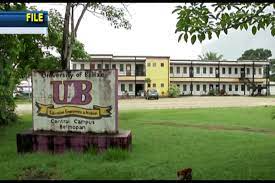
Image of the University of Belize
All the American professors lived in Belize City and after an incredible amount of effort, we were successful. Frankly, I had my doubts from time to time. Actually, many times. The University College of Belize (UCB) was established and although it has changed names over the years, it remains there today. That work is among the most gratifying of my entire career. My own experience suggests that anyone complaining about American higher education should try a posting in a developing nation–then you’ll see what real challenges are like. Still, I loved my time there.
I really didn’t know it at the time, but Belize was also considered one of the top saltwater fly fishing destinations in the entire world. It still is. I had done a little saltwater fly fishing, but not much. I was a flatlander from the Midwest. So, it was a great opportunity.
The main fish targeted were bonefish, permit, and tarpon and I spent many hours going after them when I had the time to do so. The absolutely best spot was called the Turneffe Flats. It was pretty far offshore and I had no boat down there. A problem.
I am not particularly proud of this, but I cultivated an approach to get myself on the flats as much as possible.
I lived a few doors down from a hotel frequented by wealthy and mostly American and European fly fishermen. It was also frequented by some individuals up to no good and in some cases, running from the law. Think of the bar scene in Star Wars. The Mopan reminded me of that scene. So, it was always very interesting. The Hotel Mopan also had a restaurant and a bar so…I’d put on some type of fishing shirt or t-shirt and walk down to the Mopan to see who was in town. I could often tell if visitors were fly fishermen and as I had on a fishing shirt of some type, we often struck up conversations. One thing led to another–I do not recommend that national beverage served in great quantities at the Mopan–and in more cases than you might imagine, they invited me to join them on the Turneffe. They had brought their own boats or had made arrangements with local guides. Success.
Were the fish ever there. Bonefish by the hundreds. Many fishermen go their entire lives without catching a permit, but they were there in large numbers and I landed one well over 30 pounds–on an eight weight flyrod. And depending on the time of year, tarpon moved into the Turneffe and some of them weighed more than 200 pounds. I caught many tarpon, but I must admit nothing close to 200 pounds.
I accomplished a great deal while in Belize, but my time on the Turneffe Flats was very special. I’ve been back several times and the fish are still there.
Photos of a bonefish (far left), permit (center), and tarpon (far right):
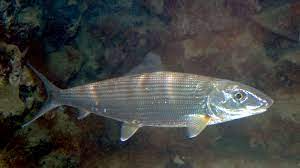
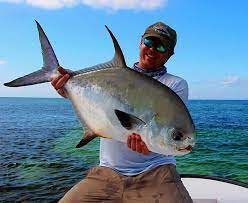
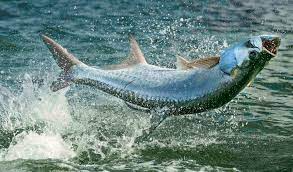
Quote of the Week
One of the first things I do when I get up is read Inside Higher Education. It provides a very quick overview of what is going on in higher education and in general, the writing is very engaging. In many issues, there’s some career advice articles written especially for new academics. I enjoyed one of those papers written by Professor Jennifer Snodgrass who offered this recommendation:
“Cling tight to those you trust and work to find relationships outside academe. Run away from those who are jealous of you or seek to tear you down for their own validation. You cannot change their minds or win them over. You will be let down by the smaller moments: faculty members who don’t answer emails, graduate students who decide to quit the program, co-authors who never finish promised manuscripts and colleagues who simply quit after tenure is received. These moments will happen, but only allow yourself the briefest amount of time to focus on the disappointment you feel and then move ahead.”
That sounds like good advice to me. Here’s the entire article if you care to peruse: https://www.insidehighered.com/advice/2021/11/18/truths-about-academic-career-people-often-dont-share-opinion
Campus update (a bit late since I was off campus several days last week) October 25–November 1, 2021
New and Expanded Initiatives
HU continues to push forward on several new and expanded initiatives in the runup to the legislative session. Nothing is guaranteed at this point, of course, but we are anticipating and hoping to establish a New Mexico Center of Excellence in Social Work at HU and things continue to look positive to establish the New Mexico Reforestation Center on the home campus. A number of other interesting and exciting initiatives are also being discussed and I remain optimistic about them.
HLC Peer Reviewer
I served as a peer reviewer numerous times when I was in a faculty role and it was a major time commitment, no doubt, but a very worthwhile activity. I really learned a great deal and of course, returned to my own campus with those new ideas. If you are interested in serving as a peer reviewer, go to: https://www.hlcommission.org/Peer-Review/become-a-peer-reviewer.html?highlight=WyJiZWNvbWUiLCJhIiwiYSdzIiwiJ2EnIiwicGVlciIsInJldmlld2VyIiwicmV2aWV3ZXIncyIsImJlY29tZSBhIiwiYmVjb21lIGEgcGVlciIsImEgcGVlciIsImEgcGVlciByZXZpZXdlciIsInBlZXIgcmV2aWV3ZXIiXQ==. Serving in this capacity is a major service commitment and should be noted and credited on any annual review.
Matanza
As many of you, NMHU recently participated in a community matanza event. It took place at the new NMHU Cultural Park. We welcomed hundreds of people to this special fall event. Our partners were the City of Las Vegas, the World College, the local K-12 systems, Luna CC, and other civic organization and private benefactors. Anyone who knows anything about these events understands how many moving parts there are and how extremely complicated things can get. And yet…it came off beautifully thanks to the efforts of an incredible number of dedicated volunteers and friends of HU. So many people put so much effort into the event, but…I would be remiss to not particularly highlight the efforts of Dr. Eric Romero…someone I have come to think of as truly one of the hearts and souls of this institution.
A few photos from the event:
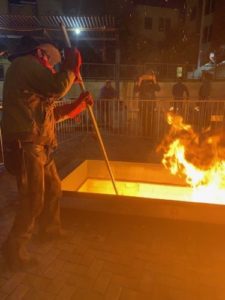
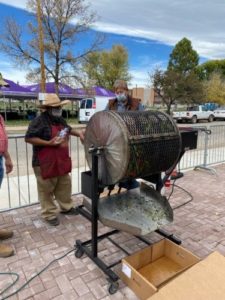
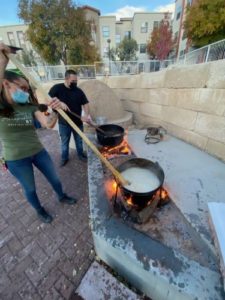
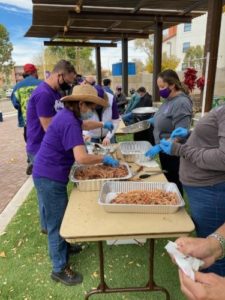
Weekend Athletics
It was a great weekend for HU athletics. The women’s a volleyball team won an exciting five set game in South Dakota and the football team scored a season-high 58 points in a victory over Adams State (58-28). HU’s quarterback, Mr. Ramone Atkins, now leads the NCAA Division II in total offense. Best in the nation. Wow. Well done!
Las Vegas Boo Fest
A number of HU folks participated in last evening’s Boo Fest. This report from the NMHU Community Liaison, Ms. Linda Anderle:
1000s of kids! Tons of candy!!
HU had passed out over 1000 sports balls, bags and bags of candy and dozens of little rubber duckies by 5pm. The event was scheduled until 8pm. Most vehicles had gone by 5pm as they had run out of goodies as well.
Our HU folks came in costume, I was so tickled: Henrietta Romero, Juli Salman, Julie Tumblety, Ricardo Martinez and Andrea Crespin.
Loretta Martin, city liaison, proclaimed the event a success!
Many thanks to everyone at HU who helped make this event a success and of course, to Linda for her leadership. It is always very important, but coming out of COVID (hopefully), it is critical that HU play a leadership role in supporting community building/social/recreational activities in our city and broader community. It is an important objective for HU and I take it seriously.
A photo from the BooFest:
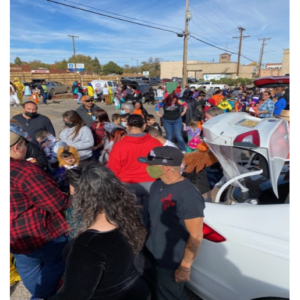
Hamatis (Latin: Barbed Wool)
Growing up in rural Illinois, I was surrounded by ponds, lakes, and streams and many of them were close enough to frequently fish. And I did. For those spots a bit further from my home, I had my trusty bike. My world was small and there were few opportunities to hear or read about fishing adventures beyond my immediate experience. But, in the 1960s, things changed a bit.
A television program was aired every Saturday afternoons called The Flying Fisherman. It was sponsored by Liberty Mutual Insurance and featured a guy named Vernon Gaddis, more popularly referred to as Gadabout Gaddis or The Flying Fisherman. Mr. Gaddis lived in Mattoon, Illinois–not very far from where I grew up. Each television show featured Mr. Gaddis flying to some interesting and I thought exotic fishing location (he was a pilot in the military). Each program was shot without sound and Gaddis later provided a monotone voice-over describing where he was fishing, what luck (if any) he had, and other tidbits about his experience at each location. He frequently talked about finding small and very out-of-the-way airstrips and apparently had some interesting and occasionally edge-of-your-seat landings.
I made a point to watch all his shows (when the family TV was operating) and he introduced me to fly-fishing. Initially, I thought that fly fishing meant that he flew to the spots he fished–hence, the term fly fishing. But then I saw his very long fishing pole (a flyrod) and heard him talk about what he was doing–he did fly to various locations and when he got there, he went fly-fishing. That was his favorite type of fishing and I longed to give it a try. I mentioned my interest to my grandfather who informed me that he had an old bamboo fly rod in the attic and I could have it if I was interested. I was very interested. He neglected to tell me that the rod was broken. I fixed it up as best I could and tried it out the very next day. I had no flies so I tied on a few feathers to a hook and got the line out after many failed attempts. On my third cast—if you wanted to call what I was doing casting–I caught a respectable largemouth bass who demolished my homemade fly and broke the rod I had just repaired. It wasn’t exactly an auspicious first fly-fishing outing, but I loved it and really, never looked back from there.
One of my favorite programs was shot on the Rio Grande River near Creede, Colorado. Here’s a brief video if you care to peruse–it is grainy and low quality: https://www.youtube.com/watch?v=5hyGf3-Y7d8
Several years ago, I fished the Rio Grande near Creede. It was a great and memorable trip, but I wish I had packed my grandfather’s old bamboo rod. That would have made it even better.
My signed copy of a book by Mr. Gaddis:
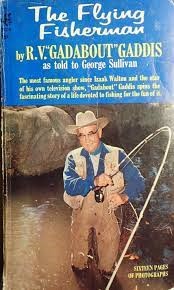
Campus Update: Week of October 18-22, 2021 (going out a bit late due to a very busy weekend)
BoR Meeting
The Board of Regents approved several measures at its regular meeting Friday that will continue to bolster our enrollment efforts.
The Board approved two new degrees, a Master of Science of Nursing Family Nurse Practitioner and a Doctor of Nursing Practice. I’ve said it before: one of the best ways to increase our enrollment is implementing new programs responsive to today’s needs. During the past four years, we have had a steady increase in our academic portfolio and, with the approval of these two nursing programs, we continue to build on that success. The two proposed programs will be forwarded to New Mexico’s Department of Higher Education and the Higher Learning Commission for their approval. I thank Director of Nursing Jeanie Flood and Provost Roxanne Gonzales along with everyone who helped push this through for their dedication to the future of Highlands University.
Highlands’ program portfolio is one of the top five priorities for me, as I outlined in my report to the regents. The other four are fiscal accountability, compensation, private giving and community connections. I feel we have made great progress in each one of these categories, but for the sake of our current students and tomorrow’s students, we cannot stop.
The Board also approved a policy mandating the reactivation of courses go through the Faculty Senate’s Academic Affairs Committee, approved changes in the graduate credit transfer language to make it more accommodating for students, and approved changes in the auditing policy that add instructor’s permission for all audits and dean’s permission for audit requests after the registration period ends.
The board also voted for a resolution that would lay the foundation for a memorandum of understanding agreement with the city and county. I know there are strong feelings surrounding the golf course, and it is my intent to see the golf course reopen while remaining fiscally responsible.
In other items, the Board approved:
• a grievance policy for addressing formal complaints of sexual harassment under Title IX
• changes to the Faculty Handbook and Academic Outcomes Assessment Handbook
• approved the financial quarterly report and certification
• revised the purchase requisition policy, and
• approved the proposed FY23 Research and Public Service projects.
New Honor Society at NMHU
New Mexico University Highlands seniors Pablo Hernandez Mendieta and Benito Vigil in September were the first to be inducted into the schools’ new national Spanish honorary: Sociedad Nacional Honoraria Hispánica Alpha Beta Lambda chapter of Sigma Delta Pi.
Spanish professor Norma Valenzuela and bilingual education professor Elisabeth Valenzuela serve as co-advisors. The honor society’s co-advisors credit Vigil, who is president of the Spanish Club, with researching the organization and bringing it to campus. Students must either major or minor in Spanish and have a minimum of a 3.0 grade-point average.
Congratulations to the students and faculty involved in this new initiative.
Hamatis (Latin: Barbed Wool)
Several years ago, I was on the board of an organization called the Consortium Center for Study in Britain (CCSB). There were about a dozen universities in the CCSB and every summer and some fall terms, we sent over a couple hundred students to do short-term classes in Britain and various lectures and seminars in France. I served as the director of the program one summer and held various administrative and faculty positions during other summer and fall terms.
It was a pretty demanding job–a couple hundred American students abroad for the first time in one of the most incredible cities in the world–what could go wrong with that?–but I did have the odd day off now and then. Fly-fishing in the U.K. was on the bucket list, so I purchased some used equipment, a fishing license (I recall I had to pass a test to do that) and planned the trip.
There was a vibrant and very active urban fishing scene in London and I learned there were several options to fish right in or near the city. There were public streams and lakes, private waters where you had to purchase a pass from the landowner, and stocked lakes that were basically business operations charging a daily fee to fish. I initially tried some public waters about a mile away from Queen Elizabeth College. The CCSB rented out that entire campus in a very nice area of West Kensington–not exactly a top fishing destination, but a really nice area of London. The well-known Portobello Road Market was a half-block away and I purchased my used flyrod and other equipment at that market.
The public waters were incredibly crowded. There were lots and lots of tangles and it was not much fun, although I met some friendly folks as we worked to sort out our hopelessly tangled lines. I considered the daily fee options, but ultimately decided to try a private stream owned by some titled individual–not sure if he was a Duke or what, but he apparently had some title and a very large house complete with a trout stream. I had to phone for an appointment, which was really a kind of interview by a guy who ran the estate. I apparently did OK on the interview (a surprise since he started the discussion by telling me that he really didn’t care for Americans), paid a surprisingly small fee, and was allowed to fish for six hours on the property. It was beautiful. Pastoral. You would never know you were a mile or so from Central London. I didn’t see a soul the entire time I was out there. I got a few rainbow trout and two carp–called coarse fish in the U.K. It was a great day.
One of the excursions we did in the CCSB was up to one of my favorite cities in the world—Edinburgh. While there, I arranged a trip on a tributary of the River Clyde and caught numerous salmon and a few grayling. It was a trolling trip, which is probably the easiest and most relaxing way to fish. You tie on a fly, get your line out there, and reflect on life while the guide slowly paddles the boat around or allows the boat to simply drift. When your flyrod dips down, you have a fish. That’s it.
Bottom line–you can fly-fish anywhere including major urban areas. It might take a bit of work to learn where to go and how to fish there, but it can be done.
A grayling (a freshwater fish in the salmon family, easily recognizable by the prominent dorsal fin) from the River Clyde:
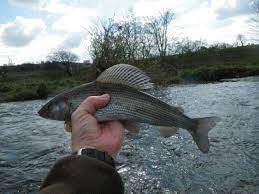
Campus Update: October 11-October 15, 2021
COVID
COVID trends appear to be going the right way throughout most, but not the entire nation.Trend lines continue to be tied to regional or even more specific local conditions, but things seem to be heading the right direction. Vaccination rates continue to slowly rise. Lots of people wish they were rising faster, but they are improving. However, many Americans are hospitalized with COVID or COVID related health issues and some die from the virus every day. I think most experts agree that the pandemic is now almost entirely a pandemic of the unvaccinated. So…. some improvements, but we’re certainly not done with COVID.
Next weekend we’ll hold our second major event under COVID conditions–a matanza. We recently hosted the 2021 NMHU Homecoming. In my head, that was our first major event under COVID. Hundreds of alums and friends of the institution were on campus. Most events were outdoors. All campus COVID requirements were in force and things went pretty well. Next, the matanza, which we’ll hold next weekend. This will also be an outdoor event and we anticipate welcoming hundreds of people.
We’ve been careful in our planning of the matanza event. Lots of people are excited that we’re moving ahead and I am optimistic all will go well…even under COVID conditions.
Get vaccinated. Get all doses you are eligible to get. Wear a mask indoors. Outdoors too if that is your choice. Distance as best as you can. Carefully choose which events you’ll participate in…and not. Try to come up for air from time to time to check your own mental health status. Seek assistance if you think you even might need it. Try to decrease your engagement in the 24/7 mostly bad news media inputs. Be kind and gentle with each other–when someone does not behave that way, give them a break. You don’t know what they are going through. HU’s guiding COVID values: (1) health and safety, (2) delivering our core mission, and (3) protecting the livelihoods of HU staff, faculty, and others.
Congratulations to our 2022 AAHHE Faculty Fellow Benjamin Villareal
Benjamin Villareal was recently notified that he has won a 2022 Faculty Fellowship from the American Association of Hispanics in Higher Education (AAHE). The primary goal of the fellowship is to prepare Latina/o/x faculty for successful careers in academia and beyond. The program is geared towards new faculty who are beyond their first year on the tenure-track. Well done Ben. This is a major professional achievement. We are lucky to have you here.
New HU Food Program
The fact that many college students face issues of food insecurity is well known and well documented. There is no doubt that such insecurity makes it very challenging, if not impossible, for some students to remain in school, make progress toward their degree, and graduate. Now, HU students have access to free food materials including canned goods, breakfast foods, pastas, and other items. Students pick up a bag and fill it with the food available at that time. This program is located in the SUB. This is a wonderful program and I support it entirely. Thanks to all who made this happen.
DEI Website
The NMHU President’s Committee on Diversity, Equity, and Inclusion has been diligently working on several important projects throughout the summer and fall terms including a major grant application, several professional development opportunities for students, staff, and faculty members, and the development of their website. Check out the site and visit it frequently to see what’s going on: https://livenmhu.sharepoint.com/sites/DEI
Two Great NMHU Faculty Members Walk Into a StoryCorps Recording Booth…
I really enjoyed listening to this interview. I was very moved by it and once again, it powerfully affirmed the commitment of NMHU faculty to our students. We are fortunate to call these two individuals our colleagues. Check it out: https://drive.google.com/file/d/1QlNBgus9U-gcsVXCWPpxt_Of-GmXf2GR/view
Bookstore Update
HU has experienced a number of bookstore problems over the years–mostly students not getting the correct book in time. That is unacceptable, of course, and we made some changes in the process in an attempt to improve our outcomes. I stipulated that we needed to get some feedback about the new process this term to see if things were improving and that has now been done. Students were surveyed about their experience (N=27) and 23 noted a positive experience–the right book before class started. That looks pretty good, but there are those four students who had some type of problem. We’ll continue to work on this to try to get to 100% satisfaction. That’s hard to do, but that is the goal.
Hamatis (Latin: Barbed Wool)
Some people, including me I might note, just automatically think that having kids or adopting them or just raising them in your home for whatever reason means an end to some favored adult activities. You have to give up the little car you love and purchase….a minivan. That’s always an exciting drive. You have to forego adult type vacations and adult-type activities during vacation. You maybe go to Disneyland instead. For me, that’s rough. You can’t purchase a white sofa. You think that all these things are over and of course, those things are so silly and ultimately ridiculous anyway. In most cases you don’t really have to give up this silliness, but you want to do so…your life has changed. I mean, does anyone really need a white sofa? They are never white for long–kids or not. Kind of ridiculous. Well…I and many others automatically assumed that fly fishing would pretty much be over when kiddos arrived. And, I found out that was also a very false assumption. You can keep fishing with kids. You have to make some adjustments, of course, but it can be done and, in the end, making those adjustments and being outdoors and fishing with your kids can be one of the most meaningful and beautiful things imaginable.
You have to slow down a bit, which is a really good thing. You have to adjust expectations and again, that’s not all bad. You catch something…or you don’t…but catching something simply cannot be the main goal. Ideally, it is not a goal at all. Again, that’s not a bad thing. While fishing with my kids, I often thought about the Wordsworth poem, My Heart Leaps Up, and the well-known line from that poem… the child is father of the man. One common interpretation of that line is that things enjoyed in childhood often continue to be cultivated and enjoyed later in life. Interest in certain activities enjoyed in childhood often “stick” as kids grow into adults. I thought (and hoped) that an interest in the outdoors and in fly fishing might “stick” with my kids and they’d continue that interest as they grew. So, they accompanied me on many fishing trips. Often, they wanted to go. Sometimes, I had to kind of drag them along. I have to say, my strategy worked. To this day, both like being outdoors and pursuing outdoor activities including fly fishing. A photo of my daughter, Brook, about to enjoy a wonderful shore lunch featuring some landlocked salmon caught (mostly by her) during a morning of fishing on Grand Lake Stream in Northern Maine:
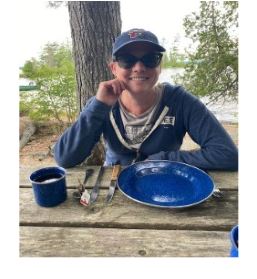
If you have an interest in fly fishing with kids, you might want to check out the magazine Dun. Here’s that site: https://dunmagazine.com/. It is really great and has lots of articles about kids and fishing and fly-fishing from a parent’s perspective. I recommend it.
Memorable Quote of the Week
This from a recent Inside Higher Ed article:
“For example, a 2015 study found that Princeton’s yearly public subsidy amounted to $105,000 per student, while nearby Essex Community College received a public subsidy of $2,400 per student. Our public resources are disproportionately subsidizing a very small and select group of students.”
Hegemony in action, no?
Campus Update: October 4-October 8, 2021
COVID
We had a zero-case COVID day this week, which is great. But one day does not a trend make, and we simply must remain diligent. I know people are weary of restrictions and the frequent planning for and then the cancellation of interesting events, but we must deal with what is in front of us at any given time. If you follow the NMDOH updates, you’ll see that we are still experiencing cases in San Miguel County and throughout the state.
I read a good article about COVID takeaways in American higher education this week, and the takeaways from the piece are certainly relevant to HU. The first takeaway was that there was a significant decline in enrollment across the nation, particularly first-time freshmen. HU experienced that very thing. The article discussed the massive revenue decrease in room and board and other auxiliary revenue and again, we experienced (and still are experiencing) that. That is a big problem, of course, further exacerbated by the fact that most universities (including HU) carry debt on auxiliary programs like residential facilities and that debt must be covered no matter what. Even if no one is renting a room–the debt comes due. Auxiliaries are covered by fees–that is, by the dollars students provide to live in that room, and we don’t receive state funding to cover those costs. The final takeaway focused on university faculty and the decrease in their numbers under COVID. Some left the academy for other work. Some retired. Some were furloughed or let go. The decrease hit part-time instructors particularly hard. We have had some retirements and some have left to take other jobs, but we have not furloughed or let anyone go due to COVID. Still, HU certainly seems to be experiencing the same challenges most everyone else is facing. No surprise there, I guess.
Get vaccinated. Get the third shot. Social distance as you can. Make smart personal decisions about where you go and what events you participate in. Come up for air from time to time to check in on your own mental health. Reach out for assistance if you think that’s a good idea. Don’t wait too long to do that. Check in on others and provide them with some human interaction. To the degree possible, try to avoid the endless 24/7 onslaught of distressing news. To the degree possible, try to avoid negative people. Be kind and gentle with each other. All free advice, of course.
Community Comment Period for Proposed Title IX Policy Open until October 15
As a result of changes in the legal requirements for Title IX, NMHU will soon present a new Title IX Policy to the Board of Regents for action, that will control how NMHU resolves Title IX complaints involving sexual harassment and other forms of sexual misconduct that occur on campus. Because Title IX procedures can affect all members of the NMHU community, NMHU is offering an opportunity for all members of the NMHU community to review the proposal and offer their comments and feedback. All interested community members are encouraged to review the Proposed Policy and share their thoughts.
You may comment on any aspect of the Proposed Title IX Policy or about the document as a whole. Comments can be short or long, positive or negative. All responses are valued! You can enter your feedback directly into the form linked below, or, write out your thoughts in a word document and upload into the form. Feedback can be anonymous or you can share your name if you choose (the only required identifier is whether you are staff, faculty, or student). Your comments will be reviewed by the Title IX Coordinator and may also be shared with senior administrators.
Until October 15, view the Proposed Title IX Policy here: https://tinyurl.com/nfpjchf2
Until October 15, post your feedback here: https://forms.office.com/r/cWSPfKS8bF
Highlands awarded grant to boost graduates in sciences
New Mexico Highlands University has received a nearly $300,000 in grant for a program to increase the number of students graduating in science, technology, engineering, and math fields.
Awarded by the U.S. Department of Agriculture’s research branch, the National Institute of Food and Agriculture, the grant will fund three years of summer programming that will boost four-year degrees in STEM fields. It will involve Highlands, Santa Fe and Luna community colleges and Community College of Denver.
“One of the biggest issues regarding STEM education is that we’re woefully short of STEM graduates,” said Ian Williamson, associate vice president for academic affairs, grants and contracts at Highlands. “In terms of job placement and job fulfillment, we’re way behind in computer science and STEM.”
Like Highlands University, the three community college partners are Hispanic-serving institutions.
Shantini Ramakrishnan, co-principal investigator for the grant and conservation and restoration education program manager at the Conservation Science Center at Highlands, said this two-week program will take place at the end of the spring semester. Students at the participating community colleges who are finished with the first year of their associate degree in science will be eligible. There will spots for eight students from each of the community colleges.
Participants will spend two weeks on the Highlands campus. Faculty from each of the four institutions will be involved in the program. Potential topics include animal behavior, water quality, soil science, bison ecology, forestry, biometrics, and harvester ants.
Well done, Shantini, and everyone who helped make this happen.
Student Affairs
The NMHU General Store (food pantry) will have a grand opening on Wednesday, October 13, from 10-2 in the SUB Room 110. This will go a long way in supporting students’ overall wellness by helping to address and destigmatize food insecurities. Joseph Dominguez and Michelle Bencomo are the staff who are leading this effort.
Hamatis (Latin: Barbed Wool)
The NFZ. Experienced fly-fishermen/women are almost always familiar with the acronym NFZ. It stands for no fly zone–meaning there is (or should be) an area around your face, head, neck, etc. where a fly should not intrude. But of course they do. I have personally been hooked by flies in my ear (numerous times), my neck, my shoulder, my back, my leg, and other areas. Once after the NFZ was not observed, a fly embedded in my nose. That really hurt. This is not a photo of me, but it is pretty close to what happened:
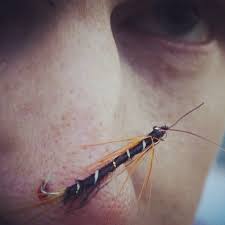
Getting hooked by a fly is usually the result of a poor cast. The back cast is too low and or the forward cast is too weak. As a result, the fly line droops and the fly might catch on anything that is in the way. Including some feature of your anatomy. Another common issue is when the fly catches on a bush or a tree and you tug it in order to free it and….the fly comes at you like a projectile from a rifle.
Hats can help. Baseball caps are perhaps the most common, but they are less than ideal. A cowboy hat works well. So do bush hats (a round hat similar to some military hats–sometimes called a boonie hat) and there are hats specifically designed for fly fishing. One is the so-called legion hat (I think it is called that because it looks like a hat worn by foreign legionnaires…not sure about that), but it looks like this:

Hat or no….if you fly-fish, you will be hooked at some point and you’ll have to remove the hook someway and somehow. There is a standard way to get that done. The most common method is to press down on the eye of the hook (if you can see it), which should push the barb of the hook upward. Get a small piece of monofilament–maybe 18 inches or so–and slide it around the bend of the hook so there are several inches of line on both sides. Then, while continuing to press on the eye, pull the hook out by the monofilament. It doesn’t always work, but it often does. It looks like this:
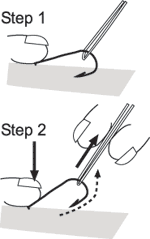
Another approach is to push the hook through your skin…that can hurt…and then snip the barb off with pliers and pull the rest of the fly out of your skin. That works too…sometimes…but again, it can be painful.
The best approach–don’t hook yourself in the first place.
Campus Update: September 27-October 1
COVID
This week HU rolled out the vax incentive program for students. Of course, we continue to comply with all state and local health mandates and all RMAC and NCAA mandates in our athletic program. We also continue to work with medical personnel from NMDOH as well as local providers who provide such great assistance and advice. More and more opportunities exist in our region for individuals who want to receive the third shot and several HU folks have already availed themselves of that option.
It does seem to me that there has been a shift from the first round of COVID when it was all about the virus, the lack of any effective treatments, and a boatload of unknowns to the place we are today. To where there are effective treatments and so much more is known about the health challenges we face. It also feels like we’ve moved from, in some cases, total lockdowns to the growing realization that some form of COVID will be with us for an extended time–maybe a very long time–to a place where many now recognize that locking down all the way as we were before, simply cannot happen or at the very least is a last case scenario. That’s just so devastating on people’s mental health and of course, the incredibly negative impact on the economy. So–another pivot.
Finally, there seems to be another change. As a campus, as a state, and as a society we finally got more organized in regard to COVID health considerations. We’re still not totally there, but we are a lot better off than we were. We are vaccinating lots of people now. We have shot clinics. We have isolation and quarantine protocols. New treatments including a possible oral medication are in the pipeline. And on and on. And we are seeing some progress. And yet, new cases continue, particularly new strains of COVID, and as a society we still have a long way to go. From my perspective, what we are not doing very well is thinking enough about the behavioral dimensions of the pandemic. Have we done enough–are we doing enough–to think about initiatives we might take to change some people’s behavior in a time of COVID? That’s a major problem today. Thus far, we’ve basically employed a typical carrot and stick approach–get vaccinated, wear a mask, etc. and you’ll receive something. Maybe a check for $100. Maybe a gift card. I read a story where a private business owner back east was providing a $10,000 cash incentive to each employee getting the shot. Incredible! All that has worked to some degree, and I’ll take that as progress, but we’re still struggling. We’ve used sticks too. Get vaccinated, wear a mask, etc. or something bad will happen to you. You won’t be able to attend certain events. You might even lose your job. And, of course, you might get sick. Very sick. Again, that has worked to some degree, but again not fully.
But the behavioral dimensions of COVID 19 are a major challenge right now. I’ve personally observed several recent instances where people who believe one thing and act one way. They come into contact with people who believe other things and behave other ways and, in some cases, some really negative things happen. Just this last week, I observed an incident in town where a woman wearing a mask, went out of her way to speak to a guy not masked. I wrote “speak to” but it really was a shouting match. Some pretty terrible language was used on both sides and although the shouting match was ostensibly about the virus, it kind of rapidly devolved into a “I’m a good person doing good things and you are a bad person doing bad things or just not doing what you should be doing” kind of argument. I understand the emotions around all that and I also think that lots of people have about had it with COVID and are ready to explode (like the ugly incident I observed). So maybe that explains what I observed. But these kinds of interactions change no minds and probably only serve to ratchet up the tensions all the way around. Surely, there is a better way to interact with each other during COVID. I have my own opinions about which of the two ideological positions I observed are right for me, but I think there just must be a better way to engage each other around all this. So…I see two major behavioral issues challenging us now–working on changing minds and behavior about what should be done to counteract the health issues associated with COVID and aside from health concerns, how to interact in a more civil way with people who have different beliefs and behave in ways we don’t approve of. All that needs some work.
Given all this, I think we should devote additional time and energy to carefully thinking through if there are any other things we might do in the behavioral domain. Social scientists have studied human behavior for hundreds of years and I think we should engage them and see if we are missing anything. I welcome people’s thoughts on this.
Get vaccinated. Register your vaccination. Wear a mask indoors. Wear one outdoors if that is your choice—it is recommended. Social distance as you can. Be aware of your mental health status. Seek help if you think that will help you. There is no shame in seeking help. None. Zero. Be kind and gentle with each other during this challenging time. That’s free. Be kind to those who are not–you really don’t know what their struggles are or how well they are dealing with them. Give them a break. That’s free too. During this time, I love the quote, “The past is history. It is gone. The future is mystery…who knows what is before us? Today is a gift. Maybe that’s why it is called the present.”
It is a rare gift that we at Highlands get to open an incredible present each and every day. That gift is the opportunity to help our students each and every day. Help them learn, achieve, and pursue their personal and professional goals. Help them graduate, get a good job, have a great career, and go on to lead lives of deep meaning and purpose. I mean…really…who doesn’t appreciate opening that gift each day?
Homecoming
It is yet another COVID Homecoming on our campus this year. Due to COVID issues, we cancelled several events and moved things outdoors to the degree possible. Even with those disappointing changes and cancellations, it has still been a wonderful Homecoming this year. Approximately 500 people attended one or more of the HU Talks events. Many thanks to all HU faculty and staff who helped with those. I viewed several of them and they were really well done. We quickly moved the Homecoming Coffee event to the SUB due to inclement weather and had a great crowd at the event. We required masking except during eating and drinking and employed other COVID safe practices. A photo of that event…most people unmasked in the photo since people were enjoying breakfast:
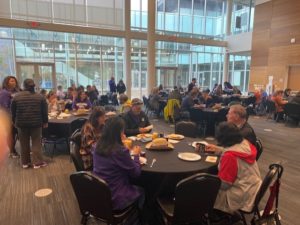
And of course, other Homecoming events will be held tomorrow including a 5k run, the football game, and other events.
Thanks to Terri, Juli S. Juli T., and everyone who worked on Homecoming this year. Thank you!
Shelter Dogs
NMHU will be hosting a world-class photographer who will be talking about her work photographing shelter dogs. Traer Scott is an award winning photographer and author of ten books including Shelter Dogs, Street Dogs, Nocturne: Creatures of the Night, Finding Home; Shelter Dogs and Their Stories and her newest book and I think my favorite, City of Dogs. That last volume chronicles the dogs (and their owners) in the boroughs of New York City. Her work is exhibited around the world and has been featured in National Geographic, Life, Vogue, People, O, the NY Times Lens Blog, Behold and dozens of other national and international print and online publications. She lives in Providence, Rhode Island with her husband, daughter and creatures. Website: www.traerscott.com.
We will soon be announcing the dates of Ms. Traer’s visit. A photo of Ms. Scott and one of her friends:

Getting To 15
A great day for NMHU. Go to: https://www.nmhu.edu/highlands-president-sam-minner-improved-compensation-is-a-matter-of-human-dignity/?fbclid=IwAR03iF8GLIwPcUtujtJSnEfErxrm_Kx_3s2elJVAJd-Shg4OBe10PnRQqhk
Improved compensation can and often does have many positive outcomes, but at the core…it is a matter of human dignity. In a wealthy nation, everyone should be paid a fair wage for their work allowing them to lead a life of dignity. Everyone should expect to have decent benefits as well. That’s my opinion.
NMHU Default Rate
Every year, the United States Department of Education provides information to participating colleges and universities regarding student loan default rates. If rates are too high, the school is faced with numerous sanctions including the inability to quickly disburse federal money to students and other sanctions that negatively impact students. We just received the information from the last year of available data:
FY 2015- 13.0%
FY 2016- 12.5%
FY 2017- 9.1%
FY 2018- 8.5%
As you can see, since 2015 we have experienced a very nice trend of decreasing default rates. In fact, our most recent rate (8.5%) is considered “excellent-very good” and places us among the top schools around. Many thanks to everyone at Highlands who helps our students find a way to pay for college and, of course, thanks to our students who behave so responsibly.
Kudos
Our own Rob Karaba recently had a paper published in Education and Social Policy. The paper focuses on the relationship (if any) between achievement as measured by test scores and social mobility. Basically, do people who score well on tests find more success overall? Make more money? Have more opportunities? Here’s the paper if you’d care to persue: http://jespnet.com/journals/Vol_8_No_2_June_2021/2.pdf.
Professor Justine Garcia recently published a paper titled The importance of environmentally-acquired bacterial symbionts for the squash bug (Anasa tristis), a significant agricultural pest. The paper appeared in the journal Frontiers in Microbiology. Another one of our wonderful biology faculty members, Professor Sebastian Medina , published a book chapter titled A Transdisciplinary Approach for Studying Uranium Mobility, Exposure, and Human Health Impacts on Tribal Lands in the Southwest United States, a journal article titled Uptake and Toxicity of Respirable Carbon-Rich Uranium-Bearing Particles: Insights into the Role of Particulates in Uranium Toxicity and yet another article titled Arsenite and monomethylarsonous acid disrupt erythropoiesis through combined effects on differentiation and survival pathways in early erythroid progenitors. All of this work represents the very high quality of our faculty. We are lucky to have them here at HU. Well done Professors Garcia and Medina!
One of our wonderful student athletes, CJ Sims, is ranked #6 in the nation among all Division II football players in the all-purpose yards category. That’s a great achievement. I should also note that after the game we played against Colorado Mines, I received a very nice email from a parent on the Mines team congratulating CJ (and our coaches and Highlands generally) on his on and off field department. That kind of message from someone affiliated or rooting for your opponent is incredibly rare, so…CJ clearly impressed. Well done.
Hamatis (Latin: Barbed Wool)
Following up on last week’s message about the great poet Jim Harrison and his connection to fly-fishing is another very early poet-fly-fishing bond—this one from one of the greatest poets the world has ever known (in my opinion)–the great Irish poet, William Butler Yeats. I think his most well-known fly-fishing themed poem is The Song of the Wandering Aengus. Here’s a few lines:
I went out to the hazel wood,
Because a fire was in my head,
And cut and peeled a hazel wand,
And hooked a berry to a thread;
And when white moths were on the wing,
And moth-like stars were flickering out,
I dropped the berry in a stream
And caught a little silver trout.
No one can deny the fly-fishing connections in this poem (e.g., a hazel wand as the fishing rod, the berry used as bait, dropping the bait in the stream, and of course, the little silver trout), but I think most scholars (and I am certainly not a scholar of poetry so I could be way off on this) think the poem is about Yeats’ well known unrequited love. You will have to read the whole poem to understand what’s going on, I think, but spoiler alert…when young Aengus gets home the fish transforms into a woman, Aengus falls completely in love with her and….then yearns to be with her for the rest of his life. That doesn’t work out. Ultimately, he searches for her forever and although he never gives up, his love remains unrequited. Many experts suggest that this poem is more than a little autobiographical as Yeats was head over heels in love and had kind of a one-sided lifelong relationship with the Irish republican revolutionary, suffragette and actress Maud Gonne. He proposed to her several times and she never accepted. I’ve heard some suggest that this particular case of unrequited love is perhaps the most famous example in literary history and let’s face it…there have been quite a few examples of unrequited love in literature. I’m not sure how autobiographical it is, but I do think Yeats was consumed by love for Ms. Gonne.
So…how common is the connection between love and fly-fishing? I don’t know of any study attempting to answer that question, but I do know this…fly-fishing is a time for personal reflection, it is often done alone, it is always done in nature, and it frequently allows and even encourages someone to take some time to reflect on what is most important in life. What really matters in the daily grind of living, working, interacting with other people who are sometimes very positive and supportive and sometimes just a pain to be around and other challenges in life…like say, for example, COVID. Fly-fishing almost requires…demands… that people slow down and think about all kinds of things…including their personal lives, their hopes and dreams, and of course, the things that matter most to them. For millions of people, love is certainly one of those things, no? During those pensive moments of waiting and hoping for a trout to rise, I imagine many people who are fly-fishing also take time to reflect on all kinds of things. I know I do. And I think many would suggest…love is at the center of the human condition, so…I’d say there is a strong connection between the two. My two cents.
An image of a young William Butler Yeats…
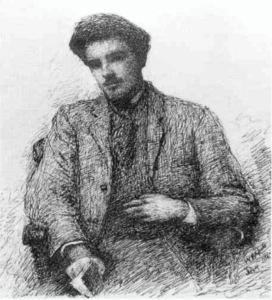
…and the love of his life, Maud Gonne:
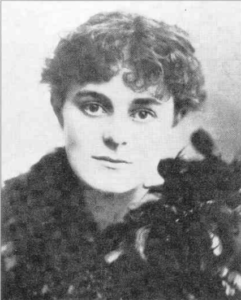
Finally…reconnecting with the poem…I have personally caught many fish using various berries as bait. Get a tiny hook, place a berry or a small part of a berry on the hook, and sling it out there. You just might catch something. It does work.
I have used berries as bait many times. I’ve also used marshmallows, corn, hot dogs and other meats including Spam (is Spam meat…does anyone really know?), sardines, bread, beans, and other human food products. Of course, I have also caught trout on tiny gold hooks with nothing on them at all.
Campus Update: September 20–September 24, 2021
COVID
We will soon roll out a student vaccination incentive program. We’ll see if that increases the number of students registering their vaccination status. The goal: everyone vaccinated or approved for an exemption consistent with our campus policies.
The COVID variant continues to run rampant and we are rapidly approaching the death toll caused by the flu epidemic from the early 20th century. And, of course, the population was much smaller then so that even makes the current statistic worse.
Get vaccinated. If you are Highlands person, register your vaccination. Wear a mask indoors or anywhere else you care to do so. Social distance as much as possible. Try to keep up with COVID news without letting it dominate your waking life. Pay attention to your mental health–social isolation and anxieties about COVID can wreak havoc on mental health. If you need mental health assistance, reach out to others and don’t feel like to have to deal with all of it yourself. Be kind and gentle with others and try to forgive those who are neither. If you want to watch some light, but at times very funny television…try Ted Lasso.
Government Relations
By all accounts, Provost Gonzales did a great job at this week’s LFC hearing that focused on compensation. In other compensation news, we recently came to terms with one of our staff unions (many thanks to both bargaining teams) and to get that money as quickly as possible in the pockets of well-deserving colleagues, I called a special board meeting to approve the deal. I have been in contact with several board members, and I fully anticipate they will do so. I told them that I fully and completely endorsed the agreement. One of the major features of the proposed agreement is to bring all employees in that unit who are below $15/hour to the 15 level. Improved compensation for all HU colleagues, but especially targeting our lowest paid colleagues, has been and remains a top priority for me. Moving from 12 per hour to 15 means an annual compensation improvement from about 25K to slightly more than 32K—an increase of seven thousand dollars. It would take more than a decade of 1.5% raises to see that level of overall salary improvement. Through careful fiscal management and focusing on core priorities, it looks like we’ll be able to do that in one year.
I have been a vocal advocate for the $15 minimum wage at HU, but I am hardly satisfied with that. I will continue to push for an even higher HU minimum as well as improved wages for all colleagues here. My motivations in all this–(1) I feel any person who works full time should be able to support him/herself and have hope that their conditions will improve. I don’t think it is OK that people in a wealthy country must work more than full-time to live with dignity. If someone wants a second job…that’s great, but I don’t think anyone should be forced to do that just to live and (2) the greatest single predictor of how well any educational organization performs has to do with the people who work there–how hard they try, how creative they are, the efforts they make to perform at high levels, etc. People matter more than any other single variable when it comes to good organizational outcomes, so it is in our best interests to get the best people we can get and then keep them here as best we can. That means they need to be compensated as well as possible. Those are my beliefs and my goals when it comes to compensation.
Serving Others
Many thanks to everyone who participated in the first Power of Service meeting this fall term. Participants heard from HU alum and courageous entrepreneur, Mr. Ron Doss, CEO of Desert Gate Internet. He provided some very inspirational advice about the critical importance of service in any enterprise and shared his personal story about how a focus on service allowed his company to compete with and prevail over much larger businesses. Well done to him, well done to HU colleagues who provide great service to others, and well done to all who took the time to participate in the meeting this week.
Hamatis (Latin: Barbed Wool)
One of my favorite authors is Jim Harrison. Jim published more than three dozen books in his life including, perhaps most famously, Legends of the Fall. He wrote poetry, novellas, novels, and numerous screenplays. He was a Guggenheim Fellow, won the Mark Twain award for exceptional contributions to American literature, and was inducted into the American Academy of Arts and Letters. He was also quite an outdoorsman.
Once to escape a thunderstorm while bird hunting in Southern Arizona, I stumbled into a bar and grill only to find Jim sitting at a table with one of his buddies and his dog sleeping by his side. He was friendly and welcoming and we had a great conversation about books, writing, the sometimes strange lives of academics (he was a professor for a bit, but didn’t really care for it, but wow…could he skewer some of the behavior of academics). He was a strong and vocal believer in the adage—those who really can’t write—teach. By the way, I know this is not always true. I’ve personally known several great writers who were also really great teachers. He absolutely loved bird hunting, and—fly fishing. A close third was the great pleasure he took in fine dining. If you ever want to lean more than you’d probably care to know about cooking wild game and other exotic dishes, try A Really Big Lunch—a really great book and one of my favorites from Jim. He was friends with the intrepid traveler and adventurous eater, Anthony Bourdain, and appeared with Anthony during season 7 of Parts Unknown. Here it is if you want to peruse: https://www.msn.com/en-us/entertainment/rf-watch-online/tv-shows/anthony-bourdain-parts-unknown/season-7/episode-4
My favorite Jim Harrison fly-fishing piece just must be Older Fishing. Here’s a passage I particularly enjoy:
“Your professional and personal problems drift away into the smell and sound of the river, into the peopleless landscape that neutralizes the poison. The connections…come together by themselves in this state of grace. This metaphor of wholeness enacts itself because you are being drawn into the patterns and rhythms of the natural world.”
I really like that line, “…into the peopleless landscape that neutralizes the poison.” Here’s the entire essay if you care to peruse: https://midcurrent.com/books/older-fishing/ –it is not a long read.
Jim passed away in 2016. One of my favorite possessions is a copy of his last book of poetry inscribed to me just a few days before his death. I will always be appreciative of our former Athletic Director’s (Bob Clifford’s) efforts to get Jim to inscribe that book to me.
And the man himself…with a nice trout and his also nice dog…I think on some river in his beloved Montana:
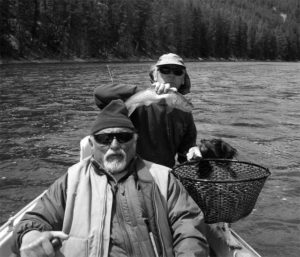
CAMPUS UPDATE — September 13-17, 2021
COVID
I imagine most people saw or heard about the governor’s order for all individuals to continue wearing masks while indoors. NMHU has worked hard to consistently implement all state health orders so that order, of course, will also be in force at HU. In an effort to further reduce COVID cases, we will also be rolling out an incentive program to add to the number of those registering their vaccination status with us and we may also implement some additional measures. I heard that the surge curve may be–that’s the critical phrase–may be–flattening at least a bit, but as is always true with COVID, we’ll just have to wait and see what that looks like. I also continue to read and hear some predictions that the fall and especially the winter could be rough. The combination of “regular” COVID, COVID variants, and the seasonal flu could certainly present major challenges. On the news last night, I heard that COVID has resulted in the deaths of 1 in 500 Americans. Incredible. I really could not believe that, but I checked a couple places and it is apparently true. Clearly, we must remain extremely vigilant. Best advice I have: get vaccinated, wear a mask, try to social distance as much as possible, and…don’t forget to attend to your mental health. Finally, be kind and gentle with others. That is free and very much needed right now.
I have detected an uptick in the number of comments made by people about what other organizations, schools, businesses, etc. are doing and more frequently, notdoing relative to COVID followed by harsh and in some cases, extremely mean-spirited comments directed toward those organizations and the people leading and managing them (e.g., this business is closed, your business is open…don’t you even care about people’s health?; that school has an online option, another school does not…what’s with that superintendent?…she should be fired!; this university has no vax mandate, another university does…shame on the former school). Given the circumstances before us, I think this is understandable, but I do not think it is at all helpful. I am not the first person to suggest that COVID hit at the worst possible time in our society. There are so many schisms and divisions and fractures in our society these days and for those inclined to participate in those divisive discussions (some seem to even enjoy them and that is kind of incredible to me), COVID presents yet another opportunity. I think everyone knows what we are doing at HU. We have a vax mandate. We have an indoor masking mandate. We have a social distancing mandate. We sponsor vaccination and testing clinics right on campus and many members of our community volunteer their time at those clinics (sincere thanks to them!). We have cancelled many events. Most of our classes are online. In some cases, our handling of student athletes exceeds both RMAC and NCAA guidelines. Generally, we are exceeding many recommendations. And yet, others feel not enough is being done.
My take on all this is that no one–not a single person–has any direct experience dealing with a virus like COVID and I have and will continue to assume that people are doing the best they can and making the best decisions they know how to make in this uncharted territory. I have personal opinions about the wisdom of what others are or are not doing right now, but I’ll leave the criticisms of what others are or are not doing to others and just will not participate in that kind of thing.
Legislative Session
Several HU administrators continue to devote more time to the upcoming legislative session. The presidents and chancellors recently focused on compensation and the very real fact that virtually all faculty members in New Mexico are compensated less than faculty members doing the same basic things at peer institutions. I think that might not be true for a few stellar research faculty members at one of the research universities, but for most, it is absolutely true. That is a major problem and apparently, has been a problem for many years—even decades. The next presentation to legislators will be about compensation and one of the presenters will be our provost, Roxanne Gonzales. I know she’ll do a great job. She’ll be joined by others from other universities including Edward Martinez, President of Luna Community College.
Cultural Park
The sign for the NMHU Cultural Park has now been installed. There are just a few minor things to be done to complete that new space on our campus. Hopefully, everything will be done before this fall’s matanza (assuming we can actually hold the matanza). Also, we will once again be doing chile roasting this fall. I think we purchased 25 bags to provide a couple servings to each person attending the event.
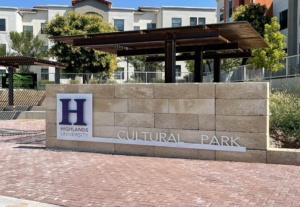
Kudos
I have personally observed many examples of deep regard for others and courage in the face of adversity during the COVID pandemic. Those examples give me hope and on some days, the ability to remain positive and optimistic (although I must admit that has been a little tough to do on a few days, but only a few). But, I think I have been remiss in not noting the extraordinary efforts of HU folks who have consistently shown up, tried to do their best, and ultimately, served our students during this terrible ordeal. In this case, I am specifically referring to the NMHU staff. Many of them hold forward-facing jobs serving students and our colleagues and many of them have jobs that simply cannot be done remotely. So, they show up. In some cases, they have been at work every single day during COVID. It is always a little risky to name people who have done or are doing great things since dozens or even hundreds of people demonstrate high efforts and I just don’t know about it, but just recently the names of two staff members–Lou Ann Martinez and Ted Gonzales–have come to my attention. I thank both of them sincerely and all staff members who continue to dedicate themselves to our noble mission. I also thank all HU folks–faculty members, administrators, and others–who continue to demonstrate deep dedication and commitment to our students during the time of COVID.
Hamatis (Latin: Barbed Wool)
Every serious fly-fisherman eventually purchases a set of waders. Lots of trout streams are just too cold to wade in shorts. I’ve fished in shorts (and jeans) before and it can be OK, but mostly….trout streams are just too cold, even in the summer. So….you put on some waders. Waders come in two basic styles–hip waders and chest waders. As you might guess, hip waders come up to your hips or waist while chest waders come up to the middle of your chest. The critical decision on which type to use is mostly about the depth of water you are fishing, but sometimes there are other considerations like water temperature (chest waders are warmer than hip waders and some of them are even insulated), the ability to carry tackle around with you (some chest waders have pockets where you can put flies, leaders, or other tackle), and safety considerations (hip waders can fill up with water before that typically happens with chest waders). However, recent debates have mostly not focused on the advantages of one type of waders over another, but what’s on the bottom of the shoe or boot attached to the waders.
The two major options are felt and rubber (or some type of composite material). Waders were initially made with felt bottoms. Felt made it easier to wade with fewer falls. Felt provided greater stability and that’s really important while fly-fishing. Many serious fly-fisherman (including me) have fallen in a stream a few times and their waders have partially or totally filled with water. That is a very serious situation and can lead to even more serious issues–including death by drowning. I’ve fallen more times than I care to remember and a couple falls were quite serious. I’ve also been around when others have fallen and I’ve seen and even taken part in some pretty dramatic rescues. Once while fishing in the White Mountains of Arizona, my friend fell while wearing chest waders. The stream was not very deep, but he walked into a hole that was over his head…maybe ten feet deep. His waders completely filled and he simply could not get out of the stream. It was a very serious matter and the only thing that saved him was the fact that the stream was pretty narrow and I could grab him from the shore and pull him in. Which I did. His waders had rubber soles and there was really not much of a cleat. Felt bottoms tend to grip a little better and I don’t think he ever wore his rubber bottom waders again. It shook him, no doubt.
But….felt waders also have some issues. Although they are good in a stream, they are not so good when you leave the stream. Mud and snow can quickly build up on felt waders and again, result in some dramatic falls. If this happens and you are not in the water…it is probably not a big deal, but I’ve seen some big falls on the banks of streams. One resulted in a broken nose. But the main problem with felt waders is the potential to bring invasive species into a stream and that happens more times that you might imagine. A small stream I enjoyed in Central Arizona was totally ruined by invasive species–some type of invasive mollusk–and the conventional wisdom was that the species initially came into the stream on the bottom of someone’s felt waders. The stream was filled with these small striped freshwater creatures and not a trout to be seen—or caught. I have been to a few spots where fishermen were asked (or even required) to disinfect their waders in a solution that killed whatever was on the bottom of their felt waders. The bottom line—waders with felt bottoms can really help with stability, but they can also bring invasive species into a stream with sometimes devastating results. For that reason, I think most people do not use felt waders at all.
Two sets of waders–rubber on the left and felt on the right:
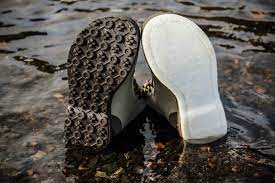
Me with my rubber-soled waders on…not sure where this location is. I would also note that fly-fishing is almost the perfect COVID safe activity and can be a real stress buster. You do it outdoors. You can do it alone. In some cases, you don’t even see another human being and trout cannot be infected with COVID (that I know of).
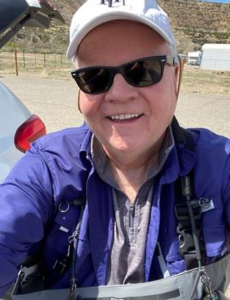
CAMPUS WEEKLY UPDATE AUGUST 30-SEPTEMBER 3
COVID, particularly the Delta variant, continues to present major challenges and everyone must remain vigilant as we face them. In addition to the various measures we are taking on campus, we will be taking some additional actions in hopes of reducing the spread. The next at-home athletic competition is a volleyball game next week. I have spoken with our Athletic Director and a decision has been made to not allow any fans in the gym for that game. At this point, this only applies to the volleyball game next week, but that could change dependent on COVID conditions moving forward. The campus has been under the vax requirement standard for a while now and beginning next week, we will be ramping up our compliance efforts. If you are on campus, you must register your vax status or be subjected to our testing requirement. Please, comply with this measure and encourage others to do the same. I have had several conversations with state health officials over the past week, and they have promised to provide us with an additional contact tracer. I thank them for that very much. We will host a free PCR testing clinic in Melody Park. The clinic will run from 10:00 a.m. to noon on Tuesdays and from 2:00 p.m. to 4:00 p.m. on Thursdays. It is available to the HU community as well as the local community. Finally, I met with other city officials (city government, K-12 schools, etc.) this week and we agreed to routinely meet at least once a week to discuss what’s happening in our various organizations, what we might do collaboratively to reduce COVID, etc.
It does seem to me that this phase of COVID is much different than others. When COVID began, more than a year ago now, there were lots of efforts to shelter in place, stay home as much as possible, and hope that things would improve. Many businesses were closed. Some municipalities mandated curfews. Lots of schools were closed or went completely online. There were no vaccines. There were lots of crazy ideas about the virus (unfortunately, I’d say that continues today). Today, it feels to me that there is a general recognition that the virus in some shape or form will be with us for some time–maybe a long time–and the focus has shifted to how we just might have to learn to live with it. Of course, not everyone agrees that we should behave that way, but when I look around, I see businesses open, restaurants serving patrons, athletic events taking place, movie theatres open, and on and on. I mostly hear about why it is important to keep schools–K-12, higher ed, etc.–safely open. Again, I have my own opinions about all that and I am sure you do as well, but that is what I see going on around me.
I remain guided by state and federal health mandates and recommendations and what I think is the best science available. This includes: get vaccinated, wear a mask indoors, social distance as possible, stay home if you are unwell and wash hands frequently. Does all that guarantee good results? No. Absolutely not. But, I do think that’s the best and safest path forward.
The physical health challenges associated with COVID are all too real and in many cases, quite terrible. And yet, I continue to be at least as concerned about mental health issues as anything else. I urge everyone to focus on their mental health at least a few minutes each day. Try to clear your mind, read a good book, see a great film, fix a wonderful meal, or whatever works for you. If you need assistance, we have free counseling services available via our HU benefit package (see the HR website). If you see someone else struggling, reach out as you can.
Every day, I see great acts of courage and sincere efforts to help others. For that, I thank you my colleagues.
Rankings
I’ve never been a big fan of university ratings. The U.S. News ratings probably attract the most attention around the country and they have been criticized for years. Basically, the tougher a school makes it to get in–the higher the rating. Not a fan of that notion. However, some organizations use different criteria and one of those ratings came out this week. Washington Monthly just came out with their “best bang for the buck” ratings. That list ranks schools according to things like return on investment–which schools lift students out of poverty or simply improves graduates’ lives the most? We do pretty well on that one–rated #76. We’re slightly below New Mexico Tech (#66) and Arizona State (#73) and above University of Oregon (#90), Northern Arizona University (#95), Western New Mexico (#194), St. John’s in Santa Fe (#210) and hundreds more.
Although I am not a fan of rankings in general, students and especially their families, are. At least sometimes. I worked at Truman State for about a decade and that school consistently enjoyed very high rankings both regionally and nationally. That’s not a surprise. When I left Truman, the average ACT score was 29 and that was (maybe still is) about the 92nd percentile. Basically, only excellent students were admitted. Retention was just not a problem. Everyone graduated—even my own son (but not in four years!). The presidents I worked for at Truman all felt the rankings were very important and I think all of them even had performance incentives in their contracts to at least maintain the top rankings and ideally, move up. Many of my colleagues there were not as enthused about rankings (including me) and frequently downplayed their importance. However, the institution once hired a firm to check on that…the critical question…was that ranking important to students and their families? They were very important and the firm told us to emphasize them even more in our promotional materials. We did and it seemed to work…we saw increased enrollment afterward. So, like rankings or not…in some cases, they seem to matter quite a bit.
Kudos
Lots of great work going on even during COVID conditions. Dr. Jesus Rivas and several colleagues recently had a chapter published in an edited book focusing on…what else for Jesus?—reptiles. Well done. Ms. April Kent was recently named Librarian of the Year by the New Mexico Library Association. That’s a great accomplishment. Dr. Ali Arshad published an excellent paper concerning the impact of COVID on the economy. Other colleagues are working on grants, new programs, or other interesting projects. However, what is mostly occluded but absolutely the most important work we do are the student breakthroughs we have every day in classes, labs, studios, during office hours, and or other interactions with staff and faculty members. That is our core work and COVID has perhaps altered the way all that gets done, but still…it is happening even under COVID and that is a truly beautiful thing.
Hamatis (Latin: Barbed Wool)
Ernest Hemingway is perhaps the most notable writer who spoke and more critically, extensively wrote about fly-fishing and fishing in general. His Hemingway on Fishing is a real classic. One of the more interesting tales about Hemingway and fishing is about his …perhaps…missing trunk of fishing equipment.
In 1940 Hemingway took a train to Sun Valley to do some fishing. Everyone agrees on that. He had packed a large trunk containing his beloved fishing equipment, especially his Hardy Fairy flyrods and his expensive and rare Everol reels–imported from Italy. But somehow and someway…the trunk didn’t make it. It was not on the train. I’ve read stories that Hemingway was so upset about the whole thing that he rarely used a flyrod afterward. He couldn’t bear the thought of his equipment in the hands of someone else. He turned to pelagic big-game fishing instead.
But, the plot thickens. A few years later, a Hardy Fairy rod came up for auction and it was said to be Hemingway’s Hardy–allegedly from the missing trunk. It sold for a lot of money and then, the provenance became suspect. Highly suspect. It was perhaps not one of Hemingway’s flyrods after all. Later, a note attributed to Hemingway was circulated asserting that his pack and his equipment was not lost at all and a later rumor circulated that some unscrupulous person promoted the lie in order to sell the equipment at auction. There’s been lots of confusion around all this and it is still not clear what really happened. It isn’t totally clear if he ever really lost his equipment at all. If he did lose it, it isn’t clear if it was ever found or where it all might be today. And rumors still persist that Hemingway was somehow involved in the whole thing to somehow benefit himself financially. Like many authors, he was often in need of additional resources. But, I would say anytime a Hardy Fairy flyrod or an Everol reel comes up for auction or for sale on eBay, take a good hard look…Hemingway’s old equipment might still be floating around.
I learned to fly-fish with my grandfather’s nine-foot bamboo flyrod and I still use it from time to time. It’s not a Hardy rod, but it still gets the job done and it is a source of great pleasure to use it now and then. I’ve broken it three times, repaired it each time (poorly) and can’t stop smiling as I string the line through the guides, tie on a tippet and a dry fly, and cast toward an (ideally) rising brown trout. And of course while I am getting all set, I recall my grandfather–Bill Wolfe–great union organizer, steelworker, and wise mentor to me. My colleagues, for me that’s a good day.
This is a decent rainbow from the Rio Chama—caught with my grandfather’s antique flyrod:
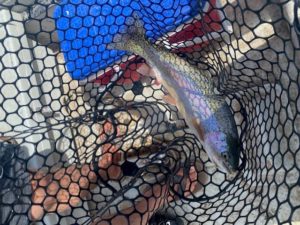
A disassembled Hardy Fairy bamboo rod…
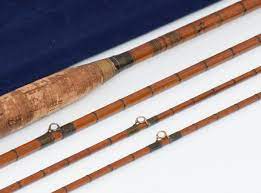
…and Papa H. himself:
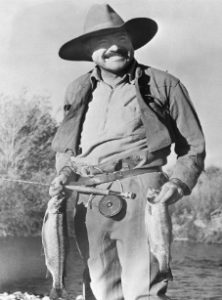
CAMPUS WEEKLY UPDATE August 23 — 27
I was out of town much of last week, but I did have the time to meet with a number of our students to discuss how the semester was going and what might be done to help them. I was so impressed with their resilience and I would say courage, but clearly, they are facing many challenges under the current COVID conditions. Their input to me was remarkably consistent–they have many COVID concerns (though most voluntarily shared with me that they were fully vaccinated), but also longed for face-to-face instruction. For many of them, Zoom classes were just not cutting it. They also shared many issues that I considered mental health challenges. Clearly, they longed for something much closer to engaging in a more typical freshmen life on a more typical residential campus. They mentioned serval faculty names as individuals who stood out to them as mentors and advocates and I reached out to those individuals to specifically thank them. My basic takeaway–mental health is of utmost concern.
Although many are very familiar with the Trinity Project and the plight of the Tularosa Downwinders, many students in New Mexico K-12 schools are apparently not. There are few curriculum materials about the Downwinders, particularly materials specifically designed for students in New Mexico. Last week I met with an advocate for the Downwinders and she is interested in working with HU to address that situation. I will be speaking with Roxanne about this project and it is my hope that some of our great faculty (and students) will get involved. The goal—research this event and then develop one or more curriculum modules. Our partner is initially interested in developing materials for middle school students. More on this as things develop.
Also this week, I met with representatives from the Instituto Cervantes (the Cervantes Institute) and they are very interested in working with us to bring their world-class Spanish language programs to HU, particularly to the Higher Education Center in Santa Fe. The Institute has similar partnerships with other colleges and universities around the globe. This from Wikipedia:
The Instituto Cervantes is a worldwide non-profit organization created by the Spanish government in 1991. It is named after Miguel de Cervantes (1547–1616), the author of Don Quixote and perhaps the most important figure in the history of Spanish literature. The Cervantes Institute, a government agency, is the largest organization in the world responsible for promoting the study and the teaching of Spanish language and culture. This organization has branched out in over 45 different countries with 86 centres devoted to the Spanish and Hispanic American culture and Spanish Language…the ultimate goals of the Institute are to promote the education, the study and the use of Spanish universally as a second language, to support the methods and activities that would help the process of Spanish language education, and to contribute to the advancement of the Spanish and Hispanic American cultures throughout non-Spanish-speaking countries.
The classes offered by the Institute are non-credit bearing (although students do receive a certificate if they successfully complete the class), but it is possible to offer credit if we wish to do so. That’s up to us. But, part of the reasoning to potentially start in Santa Fe is to make sure we do not compete with our own Spanish classes on the Vegas campus.
It was a great meeting and I will be turning this over to Academic Affairs to ascertain the interest on the campus and if there is sufficient interest, to take next steps. The Institute is a branch of the Spanish government and is broadly admired throughout the world.
Hamatis (Latin: Barbed Wool)
Very few people have been able to make a living doing something related to fly-fishing. One exception is Lee Wulff. Mr. Wulff was an author, an artist, a filmmaker, and pilot. He opened a very successful fly-fishing school and gave lectures around the world on the many pleasures of fly-fishing, particularly fishing for Atlantic Salmon. He and his wife, Joan Wulff, frequently appeared on outdoor television shows, especially The American Sportsman, which aired in the 1960s.
I met him was a kid at a St. Louis outdoor trade show and got his autograph–my very first autograph. I sometimes wondered if I was perhaps related to him in some way. My maternal grandfather’s last name was Wolfe, which he changed from Wulff when his family arrived in American from Germany. A photo of Mr. Wulff:
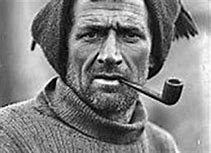
Mr. Wulff was also a very prolific fly-tier and many flies bear his name. This is one of his most famous flies–the Royal Wulff. This example is barbless (like you might use on the San Juan):
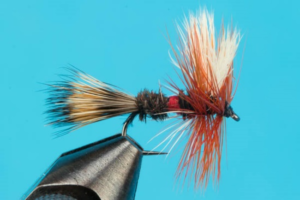
CAMPUS WEEKLY UPDATE Week of August 16 — 20
Greetings colleagues and I hope you are well. A brief update for the week August 16-20:
It was a challenging COVID week, and we had several on- and off-campus cases. In order to do more contact tracing with our on-campus cases, face-to-face classes were cancelled on Wednesday-Friday. Many thanks to all students, staff, and faculty for their flexibility in this attempt to keep people as safe as possible. We’ve added some new members to that group and hired additional contact tracers. These very rapid adjustments will likely continue as COVID transforms itself over time. My favorite COVID quote of the week: “It may sound extremely dark, but nobody knows what they’re doing when it comes to COVID. Some are just good at making the right guess, at least some of the time, and when they are right they can feign omniscience.”
Our enrollment census date is coming up and it looks like that we’ll be down in undergraduates and up in graduate enrollment. Based on most of what I’ve recently read, this is very common nationwide. Why are so many schools down among undergraduates and up in terms of graduate students? The most common thinking is that undergraduate students (usually, but not always younger than graduate students) are simply waiting for COVID to dissipate a bit so they have a better chance of experiencing a typical college life. Many of them are apparently simply taking a pause and not enrolling anywhere. In regard to graduate students, many of them are already in jobs, but were rattled by the economic downturn accompanying COVID and now seem very interested in gaining new skills, acquiring new degrees, and in some cases, ramping up skills for potential remote work. That sounds about right to me. We are experiencing success in our new Wiley partnership. The initial goal was to bring 45 new students to HU (via Wiley). That was increased to 55 and today, we actually have 60 Wiley students enrolled at HU. If you recall, we have three programs in partnership with Wiley–Nursing, the MSW, and an MBA.
Most of this week was devoted to the annual Council of University Presidents (CUP) meeting. The presidents and chancellors of the four-year schools are a close and highly functional group, and I always enjoy getting together with them. I learn a great deal when I do. Of course, there is a level of competition among the group–we all compete for students, capital outlay, research dollars, etc.–but everyone is dedicated to improving outcomes generally and we work hard to accomplish that goal. We talked about many things, but mainly focused on working to improve compensation on our various campuses, what might be done to increase the overall number of students pursuing some type of post-high school education in New Mexico, and what it might take to significantly improve our retention and graduation outcomes. There was also a lot of discussion about the funding formula used here in New Mexico.
Higher education funding formulas came into fashion several decades ago and I’ve personally worked in three states employing some type of funding formula or performance funding scheme. The basic idea is to identify what are thought to be critical outcomes (e.g., graduation rates, infusion of grant dollars, etc. and believe me, getting agreement on those is not easy) and then provide a financial incentive to colleges and universities to improve them. That’s the idea, anyway. Here’s a decent overview of these programs (https://sr.ithaka.org/publications/an-overview-of-state-higher-education-funding-approaches/). If you want to just read the conclusions of the paper, here they are:
First, we suggest that states determine levels of adequacy–the minimum threshold of funding that would provide colleges with the capacity needed to serve their students properly. Second, adequacy thresholds alone may perpetuate inequities if states do not adjust funding formulas to account for differing needs across students and institutions. States should ensure that adequacy levels incorporate the unique needs of subgroups of students, including lower-income students, racial and ethnic minorities, and students with disabilities, to name a few. Finally, performance metrics are one factor that states can consider as they determine the equity and adequacy needs of institutions and work to improve underperforming institutions. We recommend that performance metrics be used to identify areas of need rather than to penalize institutions.
I’d say these findings are consistent with most research examining funding formulas. Namely, let’s fund higher education in an adequate way first and then…let’s discuss performance funding. There will be a state group examining our existing formula in New Mexico. If you have any suggestions about how the formula might be/should be adjusted, please let me know.
This week I’ve heard several colleagues talking about the new Netflix series, The Chair. It is about a new department chair (Sandra Oh) who is the first female and minority English department chair at some anonymous university. As you might expect, she faces the usual challenges (e.g., budget issues, personnel issues, generational issues among the faculty, etc.) along with some personal drama thrown in to make things even more interesting. And by the way, the department is basically a dumpster fire. I think the entire first season is now available on Netflix.
A portion of the review from the Wall Street Journal:
“…The Chair is full of charm, and a captivating humor, a kind evident during a faculty party. It may not be the best of times for celebration but celebrate the faculty does anyway in the midst of job worries and ominous administrative directives like the one that requires longtime Chaucer scholar Joan Hambling (a wonderfully regal Holland Taylor) to be moved to a darkish basement office, part of the dean’s bullying strategy to encourage retirements. Prof. Hambling isn’t inclined to take this unsubtle hint of her reduced status lightly. She’s one of the faculty members whose age and long employment at Pembroke make her a prime candidate for one of the job cuts the administration yearns for. The celebration in question is in honor of the appointment of the first female chair of the English Department.”
The many foibles and idiosyncrasies of life in the academy have been the stuff of many novels and films and in most cases, those books and movies skewer some of the longest-standing traditions in the academy. Let’s face it—what is sometimes very important to us seems kind of ridiculous to non-academics. Writers and filmmakers often exploit that kind of thing as they portray what we do and how we think. The Chair is the latest depiction of life in higher education. Take a look if you have a Netflix account. Here’s a trailer: https://www.netflix.com/title/81206259
This week marked the passing of Mike Rose, Mike was a giant in the field of literacy and critical theory applied to preK-16 education. As a faculty member, I drew from and assigned several of his books, particularly Why School, Back to School, and one of my favorite books on writing, When a Writer Can’t Write. Due to a mix-up, Mike was accidentally placed for a time in a “voc-ed” track in high school and that experience really influenced his overall philosophy and his professional work at UCLA and other schools. His well-known essay “I Just Wanna Be Average” touches on his experience in voc-ed classes and the discrimination he suffered there. His work often focused on how uneven the playing field is in public K-12 and higher education and how those systems serve to promote cultural reproduction. He was a giant in our field. Here’s an excerpt from the I Wanna Be Average essay:
“It took two buses to get to Our Lady of Mercy. The first started deep in South Los Angeles and caught me at midpoint. The second drifted through neighborhoods with trees, parks, big lawns, and lots of flowers. The rides were long but were livened up by a group of South L.A. veterans whose parents also thought that Hope had set up shop in the west end of the county. There was Christy Biggars, who, at sixteen, was dealing and was, according to rumor, a pimp as well. There were Bill Cobb and Johnny Gonzales, grease-pencil artists extraordinaire, who left Nembutal-enhanced’ swirls of “Cobb” and “Johnny” on the corrugated walls of the bus. And then there was Tyrrell Wilson. Tyrrell was the coolest kid I knew. He ran the dozens’ like a metric halfback, laid down a rap that outrhymed and outpointed Cobb, whose rap was good but not great — the curse of a moderately soulful kid trapped in white skin. But it was Cobb who would sneak a radio onto the bus, and thus underwrote his patter with Little Richard, Fats Domino, Chuck Berry, the Coasters, and Ernie K. Doe’s`mother-in-law, an awful woman who was “sent from down below.” And so it was that Christy and Cobb and Johnny G. and Tyrrell and I and assorted others picked up along the way passed our days in the back of the bus, a funny mix brought together by geography and parental desire. Entrance to school brings with it forms and releases and assessments. Mercy relied on a series of tests, mostly the Stanford-Binet,’ for placement, and somehow the results of my tests got confused with those of another student named Rose. The other Rose apparently didn’t do very well, for I was placed in the vocational track, a euphemism for the bottom level. Neither I nor my parents realized what this meant. We had no sense that Business Math, Typing, and English–Level D were dead ends. The current spate of reports on the schools criticizes parents for not involving themselves in the education of their children. But how would someone like Tommy Rose, with his two years of Italian schooling, know what to ask? And what sort of pressure could an exhausted waitress apply? The error went undetected, and I remained in the vocational track for two years. What a place.”
A photo of Mike Rose:

NMHU faculty continue to do outstanding work in the area of grants. We recently won a National Science Foundation award—a $3.8-million project. Wow. The project will provide 16 scholarships for both graduate and undergraduate students studying biology, chemistry, computer science, mathematics, and geology. The grant will fund travel, research, and publication opportunities for students, and will provide them with job skills for future employment. Many thanks to Gil Gallegos, professor of computer science, professor Tatiana Timofeeva, professor Michael Petronis, professors Shipra Gupta, Luis Raul Castaneda Perea, and Naveen Singh, and the director of the university’s center for Achievement in Research, Math and Science, Kelly Trujillo. Well done to all and thank you for your efforts.
We are also working with some legislators and state officials to bring new resources to the campus to establish a forestry reforestation center. This could be a major project for us including new program offerings, multiple collaborations with other universities and the private sector, a new building, and possibly a new revenue stream for the institution. One potential aspect of this initiative pertains to the use of drones to reforest areas devasted by drought, fire, etc. Here’s an interesting story from Forbes about the use of drones to make our forests and woodlands healthier and more verdant (go to:https://www.forbes.com/sites/jamesconca/2020/09/30/drones-can-reforest-the-planet-faster-than-humans-can/?sh=152ea016341f). More on all this as things evolve, but I am very hopeful.
To mend means to fix something. You mend some socks. You can mend a shirt. That word is also often used in fly-fishing. It is called mending your line or sometimes called “fixing” your line. One critical variable in successful fly-fishing is somehow and someway getting your fly to move through the water column in a natural looking way. If your fly is moving faster than the current, trout usually will not bite. Same if it is moving slower than the stream–again, probably no bite. But flies move faster or slower than the stream flow all the time. That’s when you need to mend your line. If you are fishing a dry fly (one that floats on top), it is pretty common for the fly to move too quickly. If you have a lot of line out (you’ve made a long cast), the mass of the fly line floating on top can sometimes build up energy and move the dry fly too fast. The fly is moving faster than the flow. You need to mend your line by raising your rod tip and flipping the line upstream. This (if it works) will serve to slow the fly down a bit causing it to float, ideally, at the same rate as the stream. If you are fishing a dry fly or a streamer or something like that (something that is intended to be near or on the bottom), your lure might be moving at the wrong pace. Again, you might have to mend your line by raising the rod tip and flipping it downstream. Once again, if it works, that will serve to slow the fly down and get it deeper. I’ve taught fly fishing a couple times in my life and I’ve told my students so many times–mending line in an effective way is just as important–maybe more so–than casting. There’s a fly-fishing bromide that is relevant here…if the float is wrong–the day will be long. In other words, mend that line to do everything possible to make the float look right and natural.
In the photo below (sorry for the low quality), the tide was coming in very quickly in the Mosquito Lagoon (FL), and I had to aggressively mend my line to match the flow. As you can see—it worked. That’s a very large redfish, sometimes called a channel bass. They are sometimes also called “shoulders” to describe their strength and how tough they are to land, especially on a flyrod. I caught and released this fish in Florida and for most of that summer, this one was a local record on a fly.
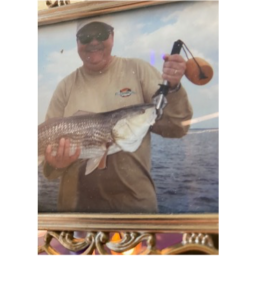
CAMPUS WEEKLY UPDATE Week of August 9 — 13
I want to thank my colleagues who emailed or phoned me after my campus address on Thursday and or the Board meeting where we discussed new campus COVID precautions. All campuses are appropriately places of vigorous debate and lots of ideas about how things should work and frankly, that’s one of the things I love about working on college campuses. I assure everyone, I listen to all input and in many cases, reflect on it right up until the time a decision must be made. I think that’s an important part of my job. Still, the positive and supportive comments, particularly about my contract extension, were really appreciated. I assumed everyone was aware of that, but apparently not. As we launch the fall term, I will be scheduling the typical once per month Coffee with the President meetings (they may be virtual again), some open office hours, and of course, anyone can make an appointment with me via Maria. I’ve also been working with the Student Senate to schedule routine breakfast meetings with students (no agenda, just conversation). I’ll be attending all the faculty senate meetings I can attend and will also attend all staff and student senate meetings when invited (and in town).
This week the university presidents and chancellors met to prepare for our annual Council of University Presidents meetings. They’ll be next week in Santa Fe. This is an important set of meetings for CUP–we establish our common legislative agenda, discuss tactics to hopefully move the agenda forward, and meet with numerous elected and state officials to discuss ways to make New Mexico higher education better. At this point, we are, once again, stressing compensation increases and new resources to help get us closer to pre-recession funding levels.
An interesting piece from the Santa Fe paper pertaining to population changes in New Mexico (check out the photo of Las Vegas in the article; go to: Census: Rural New Mexico becoming more rural. The state of New Mexico did add people from 2010-2020, but only about 58,000 in total with most of those individuals moving to Rio Rancho and other more urban areas. Most rural counties lost population. For example, San Miguel County moved from 29,393 to 27,201–a loss of 2,192 residents or about a 7.5% decrease from 2010-2020. The City of Las Vegas moved from 14,043 to 12,919 (I think that’s a 2019 number; not from 2020) for a loss of 1,124 or about an 8% loss. Mora moved from 4881 to 4189; a 692 loss or a 14% decrease. Raton moved from 6885 to 5938; a loss of 947 or about a 14% decrease. On the other hand, Santa Fe moved from 67,947 to 87,505; an increase of 19,559 or an increase of about 28%. These data are of great concern for many reasons (I personally prefer to live in rural areas and I know others move here to have that kind of life), but one of the challenges pertains to our recruitment efforts. The so-called “rule of 50” or sometimes called “the rule of 75” is that the majority of students at regional comprehensives come from 50-75 miles around the campus. Every school recruits from beyond those ranges, but the rule has generally held true for many decades. With dwindling population in our service area, we simply must make more efforts to recruit from beyond our historical catchment. Obviously, we will never stop serving our traditional service area, but we must look beyond it for growth. We are doing that, and we must continue.
A photo of the recent Math Leadership graduates, NMHU officials, and our LANL partners. Photo taken in front of the new LANL offices in Santa Fe. I think this event was the first event in LANL’s new Santa Fe space.
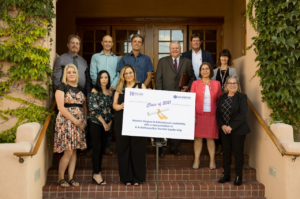
NMHU was pleased to host Lt. Governor Howie Morales to our campus this week. He visited a couple organizations and agencies in Las Vegas while he was here and spent some time with me and later, our deans and other campus officials (e.g., the AD, the Faculty Senate Leadership, etc.). The Lt. Governor has been and remains a strong and important advocate for HU and the entire higher ed sector.
We were informed this week that our proposal to offer the Bachelor of Science in General Business was approved by the New Mexico HED. Still some steps to take (e.g., HLC), but we are moving forward with that program. Well done to all who helped make this happen.
This week I and others prepared for the NMHU presentation on Capital Outlay. Once again, we were proposing a demolition and rebuild of the Facilities Building. The building is in very poor condition, has no insulation whatsoever, has several ADA issues, and most critically, issues with fire suppression and other safety concerns. Plus, it houses a significant number of HU employees who deserve an improved work environment and on top of everything else, it is right in front of the Trolley Barn–one of the most attractive buildings on our campus. I think the hearing went well…now we wait.
Hamatis (Latin: Barbed Wool)
Many people question me about my interest in and commitment to fly fishing when I so frequently come home with nothing whatsoever in the creel and no trout for breakfast. Apparently, some people believe that the major goal–maybe the only goal–of fly fishing is catching a bunch of fish. Many dedicated fly fishermen (and women) think that’s way off. I do too. For many of us, a day on the stream is as much about being in nature and reflecting on the beauty there as catching a fish. A few months ago, I was fishing in the middle of the week and I think it might have been the longest stretch in many months when I was totally alone. I didn’t see anyone. I didn’t talk to anyone and after an hour or so, I could literally feel my breathing slowing down and my shoulders lowering from up around my neck to a more normal and relaxed position. An eagle was nesting in a tree near where I was fishing and believe me, that glorious bird was catching plenty of fish. I watched him or her (I certainly cannot tell the difference at all…my biologist colleagues…is there a way to tell?) swoop down at least three times and attempt to catch a fish. It was nature at a most brutal form, but…it was also a very beautiful thing. I must have watched for an hour or so. I (and many others) often compare fly fishing to art. I am not an artist, but some artists I have known told me that one way to define art is a representation (realistic, evocative, etc.) of something in the world produced after careful observation and reflection. I’d say, that’s at least close to fly fishing as well. You need to carefully observe what is going on in the stream. Where are the areas that might hold a fish? What are the best spots to cast so you don’t scare the fish away? What’s happening below the surface? On it? Do you see any bugs? What do they look like? Do you have a fly that looks like those bugs? After all that observing and reflection, you make choices and work to select a fly and a cast to represent that small piece of the world right in front of you. Kind of like making art.
Of course, you can also just tie on anything at all and cast it out there and see what happens. Even that makes for a good day. Another good day–take your fly stuff and a good book…and just read the book. Another good day–take your fly equipment, a good book, and a lunch and just have lunch. Maybe a nap. You really can’t go wrong.
Talk about the beauty of nature and a great spot to reflect on just about anything…how about this image of Grand Lake Stream, Maine. Of interest to academics, every summer some of the top economists in the nation hold meetings in the village of Grand lake Stream and they have done so for many years. Rumor has it that trickle-down economics was hatched at a Grand Lake Stream meeting. I hope the economists there at the time of the discussion had more luck fishing than they had with that economic initiative. Various boards and think tanks also routinely meet there. The Penn State Board of Trustees was meeting there while I was fishing.
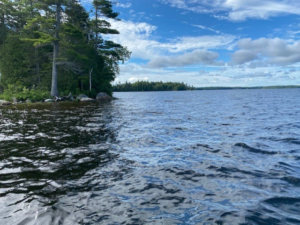
CAMPUS WEEKLY UPDATE Week of August 2 — 6
One of the first things I do each morning is read Inside Higher Ed, and I was struck by one of the articles appearing on Wednesday. It captured many of my sentiments and feelings exactly. The author, Matt Reed, is one of my favorite contributors to IHE. I’ve also heard him speak once or twice and he’s down to earth, but very smart and I would say, very much in line with how so many HU staff, faculty, and administrators feel about things. He’s one of us. Here’s Matt’s article: https://www.insidehighered.com/blogs/confessions-community-college-dean/strains
We are starting to see some use of our (at this point, only) electric university car. I hope more people use that vehicle over time. I know it takes some getting used to, and I know that you must be cognizant of the locations of charging stations, but…I remain committed to going electric as we can. Perhaps you saw the recent editorial in the Albuquerque paper: https://www.abqjournal.com/2416947/nm-right-to-accelerate-toward-cleaner-new-cars.html.
The various opinions about COVID responses continued this week. One of the more interesting developments pertained to a proposal by a few elected officials to strip federal funding from any public university mandating certain COVID restrictions. Obviously, I’ll have to monitor this closely, but I think the chances of this really happening are low…but not zero. Here’s an article about this: https://www.abqjournal.com/2416293/herrell-cosponsors-bill-that-could-strip-universities-of-federal-funds-ex-dpnm-chair-calls-the-move-not-only-unacceptable-but-also-dangerous-for-all-americans.html. I have been working closely with various health experts and others on COVID matters, and will be making a COVID announcement soon. Many trends are going the wrong direction (again) and I think we must adjust accordingly. As one physician noted, “COVID 19 may be at least partially behind us. COVID 21 is here now and it is raging.” Of course, the greatest challenge right now is the Delta variant and to make matters worse, many experts believe that there may be additional variants this fall.
I met with the officers of the NMHU Staff Senate this week and we reviewed the results from the Staff Senate Workplace Quality Survey for 2020-2021. I was pleased to learn that 83.3% of all respondents (N = 60) would recommend NMHU as a good place to work. Findings from some studies suggest that about 85% (or so) of employees hate their jobs https://www.staffsquared.com/blog/why-85-of-people-hate-their-jobs/, so if that is true, we are looking pretty good. Of course, there is always room for improvement and several suggestions were made to make the workplace better including more time for training, more opportunities for advancement, and more and or more frequent recognition for jobs well done. Several respondents also recommended continuing work in equity and inclusivity. Some concerns were noted pertaining to the treatment of some staff by others on campus. We identified a small number of things we might/should do to address some of these issues and will roll them out this fall. I want to thank the Staff Senate for their work on this survey and moving toward action in a collegial and productive way. In my experience, internal surveys often result in little or no changes at all, particularly if there are many unconstructive criticisms. But, the conversation I had with Staff Senate officers was very direct and honest, but also constructive and I’d say definitely designed to improve HU. Well done, my colleagues.
I hope you’ve had a chance to visit the NMHU Virtual Cowboy Art Show. It is always great and this year’s show is no exception. Here’s a link to visit: https://www.nmhu.edu/fourth-annual-cowboy-art-show-on-view-virtually-at-highlands-university/
Everyone may already know this, but New Mexico is extending the cash incentive program to encourage vaccinations. Here’s the details: https://www.currentargus.com/story/news/local/new-mexico/2021/07/29/new-mexico-covid-vaccine-incentives-august-offer-another-round/5423466001/.
Lots of planning underway for the 2021-2022 Cowgirls and Cowboys athletic seasons. If we want to compete, we’ll have to strictly adhere to the RMAC and NCAA COVID requirements, which are quite stringent. Planning is also underway for the Vatos season. We went through this kind of planning last fall and of course, only competed in a few matches. Let’s hope we can move forward this year, but we must be nimble in the face of COVID’s ever changing status. Many thanks to our student athletes, our coaches, and others who are working with all this without any certainty at all.
It was a busy week–in addition to normal duties and numerous COVID meetings, there was lunch with a prospective Foundation board member, a very nice graduation celebration honoring the first cohort of graduates in our math leadership program, hosting the Legislative Health and Human Services Committee, and more.
Hamatis (Latin: Barbed Wool)
We are really blessed to have several tremendous trout fisheries here in New Mexico, but few if any can really compare to the San Juan river behind Navajo Dam. Opened in the 1960s amidst much controversy, the dam turned the warm, muddy and highly seasonal river to a cold-water stream producing one of the best rainbow and brown trout fisheries in the entire nation. The San Juan is designated a Blue Ribbon fishery. A Blue Ribbon designation is made by the United States government and sometimes other authorities to identify recreational fisheries of extremely high quality and the San Juan is very high quality to say the least. If you want to try some top-notch fly fishing right here in New Mexico, take a day and visit the San Juan. If you fish in the Quality Water section, you’ll need to use barbless hooks and abide by numerous other special regulations. But, you will not be disappointed. Here’s a typical rainbow from the San Juan River.
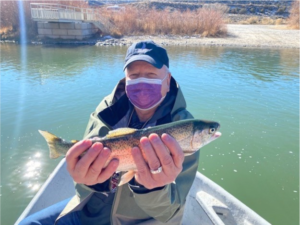
CAMPUS WEEKLY UPDATE Week of July 26 — 30
This week was yet another week filled with local, statewide, regional, and national meetings pertaining to COVID. I imagine everyone has seen or heard about the CDC’s newest recommendations and on Wednesday afternoon, when the New Mexico Department of Health held a meeting focusing exclusively on issues here in New Mexico. I also had a lengthy meeting with other RMAC presidents and chancellors as we get closer to fall sports. Then, on Thursday, this from the Governor: https://www.abqjournal.com/2414518/gov-to-state-workers-get-vaccine-or-prepare-for-lots-of-tests.html
After getting this news, I immediately called HED Secretary Stephanie Rodriguez who informed me that, after consulting with her colleagues, the Governor’s orders did not apply to institutions of higher education. That could change of course, and the pace of change is but one of the many challenges of COVID. A group gets together to discuss some COVID related issue and before that’s done, something changes. A state health order is added or rescinded. New guidance from the CDC. And this week was a great (terrible?) example of what I am referring to — lots of announcements, some changes, and a vigorous churn. I have received a couple messages from students, their parents, the staff, the faculty, and community members and I listen carefully to each bit of input, but as you might imagine, it is all over the place because people have very different ideas about what should be done. I was struck by an epidemiologist recently quoted in the New York Times who said something like, we have moved from a cloister type of situation to a new reality that we are all going to have to find some way to protect ourselves and others (with no guarantee of either) to a place where that is certainly important, but also trying to find a way to live — to co-exist — with COVID. That struck me as maybe about right. Get vaccinated — that’s still the best path forward, in my view.
This fall (COVID permitting — I am so weary of that phrase), we’ll be bringing the acclaimed photographer Ms. Traer Scott to campus to do a talk and book signing focusing on her images of shelter dogs. Here’s her website: http://www.traerscott.com/ and the cover of her wonderful book.

There will be an event on our campus and a community event supporting the local animal shelter. We’ll also be bringing the long-form documentarian, David Sutherland, to screen and do an after film talk and Q&A session on his film, Marco Doesn’t Live Here. Mr. Sutherland is one of my favorite documentary filmmakers (check out Kind Woman, Country Boys, and or The Farmer’s Wife). I’m not sure, but I think you can screen these films for free on the NPR website — most of his films air on NPR. The Marco film is about a Mexican citizen who comes North and eventually marries a woman in the US. He returns to Mexico and gets stuck there — tragically separating him from his family. We’ll have two screenings of the film — one for NMHU folks and one for the community.
I am so proud of the NMHU cohort who will be graduating with our program in Educational Leadership with a special concentration in mathematics. This initiative is in collaboration with LANL — another great partnership we have with them (among many). I always hesitate to point out a single person or even a small group who spearhead some new thing, but I would be remiss to not acknowledge the contributions of the Dr. Robert Karaba and others in the School of Education who helped make this happen. Here are a few more details: https://www.nmhu.edu/six-highlands-graduate-students-earn-a-degree-in-a-pilot-program-in-math-leadership/. I think New Mexico ranks 49th in math achievement. No-one thinks that is OK and this program will do at least a little something to help move that needle. Well done to all involved in this.
We are planning some new activities for students living in our residential facilities, including a bus/van tour of the city and several key locations of potential interest to students. The families of students will also be invited to participate during move-in. The basic idea is to familiarize new students (and their families) with the city and offices, services, etc. they might need. Of course, the tours, how we conduct them, etc. might be impacted by COVID restrictions. Here’s a promotional flier for these tours:
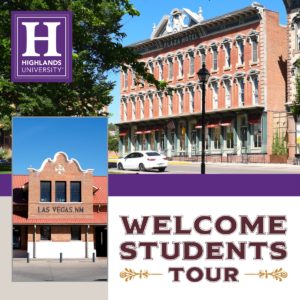
If you participated in the face-to-face or virtual board meeting last week, you learned that Baker and Associates was selected by the board for the renovation of Sininger. It is important that HU folks have opportunities to make recommendations about what that renovation might look like. The opportunity to redo a major campus building only comes around every 30 years or more so we need to try to get it right. Of course, I think every new or renovated building I’ve been involved in over the years has begun with lots of great ideas and often, sky-high expectations. That’s OK, but the reality of what things actually cost soon sets in. For a building like Sininger, a lot of cash (much of what we have) will go into infrastructure like HVAC, plumbing, roofs, and other necessary improvements that cannot readily be seen, but are nonetheless necessary. Speaking only for myself (and given what we went through and continue to go through with COVID), I am interested in trying to engineer some nice outdoor spaces for instructional and other purposes.
You may have already seen our newest promotional piece. I think it is really great and captures much of what is special about this place. We’ve received lots of positive feedback about the production value and especially the messaging. If you want to take a look, here’s a Facebook link to see it: https://www.facebook.com/HighlandsUniversity/videos/403732643931273 Thanks to University Relations for a job well done on this.
HU continues to get some positive press related to some work done by former faculty member and Jefferson Science Fellow Dick Greene. I have not kept close track, but I think his work regarding the benefits of walking is among the top media hits we get here at NMHU. Here’s the latest (May 2021) that came to my attention: https://www.eatthis.com/what-going-for-a-morning-walk-does-to-your-body-says-science/.
Things are moving forward on the NMHU Cultural Park. A photo of the horno there:
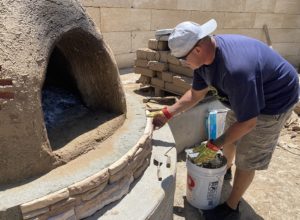
Hamatis (Latin: (Barbed Wool)
Norman Maclean was an academic (University of Chicago) and, of course, an avid fly fisherman. He is also the author of what is arguably the greatest fly-fishing book ever written, and some critics even list that book as one of the greatest American novels of all time. The book, A River Runs Through It, was published in 1976 to widespread acclaim. The film by the same name also won numerous awards and is on several Top 100 American Film lists. Both the book and the film are certainly some of my favorites. I’d recommend both to you without reservations.
The first line of the book (“In our family, there was no clear line between religion and fly fishing”) and the last line (“I am haunted by waters”) are very well known. I once even got a Jeopardy question right when I knew the book where that last line was from (although I did not answer in the form of a question, so technically, I did not get it right at all), but my favorite passages are these:
“Poets talk about ‘spots of time,’ but it is really fishermen who experience eternity compressed into a moment. No-one can tell what a spot of time is until suddenly the whole world is a fish and the fish is gone.”
“We can love completely what we cannot completely understand.”
Stay safe. Try to stay optimistic under these challenging conditions. Let’s be kind and gentle with each other.
All the best,
Sam
CAMPUS WEEKLY UPDATE Week of July 19-23
NMHU faculty continue to perform at a very high level in grants and contracts. Last week, we were informed by the National Science Foundation that we’ve been funded for $3.8mil to support a project titled BioPACIFICMIPcollaboration in design, synthesis and application of metal-organic hybrid biomaterials. The PI on this is Gil Gallegos. Tatiana Timofeeva, Kelly Trujillo, Mike Petronis, and Javier Read de Alaniz (UC-Santa Barbara) are Co-PIs. Well done to these good colleagues and thank you for your efforts. Last week, we were also informed by Senator Lujan’s office that we’ll receive about 300K to encourage greater participation in some STEM disciplines. More on this one as we develop a joint press release with the Senator’s office. Chemistry professors Arcadius Krivoshein and Tatiana Timofeeva, and natural resources professor Michael Petronis, were recently awarded a National Science Foundation grant of $150,000 that will go towards the purchase of a special microscope. The microscope, which is used to perform Raman spectroscopy, is a relatively new technology that has been increasingly used by many industries over the past ten years—including pharmaceuticals, geology, forensic science, and quality control, among others. The microscope will arrive on campus in September and will be available for classroom use as well as for students’ senior projects and theses. We’ve received several other grants over the summer and depending on how frequently you check the HU Website over the summer (I hope not too frequently), you may have missed them. I’ll try to catch people up over the next several weeks.
Fall enrollment projections appear to be stable at this point—little or no gain in undergraduates and some gains in graduate students. Of course, the numbers that count are those at census date, so these are projections only. Much of the improvement in graduate enrollment is in our Alternative Teacher Education Program, the new online program in Social Work, and other students from Wiley.
Our own former Vato and HU alum, Kevon Williams, is participating on the USA rugby team in this year’s Olympic games. Kevon was a standout rugby player here at HU and a wonderful example of how HU can help students graduate and achieve great things in their lives. At this point, Team USA is 2-0 with a tough match with South Africa coming up. Mr. Williams played very well in both matches. A link to an article in the Optic: https://www.lasvegasoptic.com/content/tokyo-bound
I cannot say how much I appreciate the continuing work of the HU Sustainability Task Force. These totally volunteer faculty, staff, and student members are leading the way to make HU better stewards of our precious environment and modeling what great stewardship looks like. To all those who dedicate their precious time to this initiative, I thank you sincerely.
Hamatis
Hamatis is Latin for “barbed wool” and that phrase is one of the earliest descriptions of fly fishing. There was a small book titled Hamatis by an ancient sportsman and devotee of the sport. I think the author’s name was Autus, but not sure. Apparently, someone back then had the idea to wrap some wool on a bronze hook and sling it into the water and…voila…the guy was fly fishing. Today, modern fly fishing is one of the fastest growing sports in the world, possibly due to the many pressures and anxieties related to COVID. Fly fishing is a highly reflective pastime and I’ve personally found it difficult to be overly anxious or worried while pursuing the sport. The fact that it is often done in some of the most beautiful settings imaginable doesn’t’ hurt either. Coming out of COVID, people seem to seek out peaceful and reflective pastimes like fly-fishing. During the 2021-2022 academic year, I will conclude my weekly (or almost weekly) campus reports with a line or two under the heading Hamatis.
A photo of me in Northern Maine practicing the sport of hamatis…but in my case, the result of me casting a nymph (a type of fly) in Grand Lake Stream, Maine while the air temperature was about 35 degrees. That’s a 23-inch smallmouth bass.
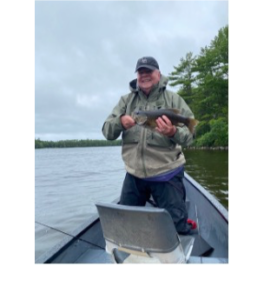
All the best,
Sam
